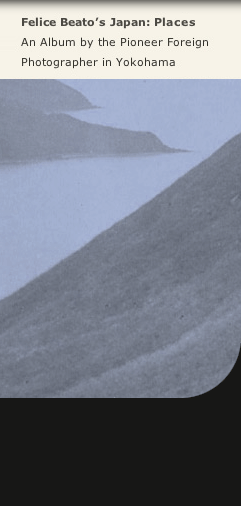
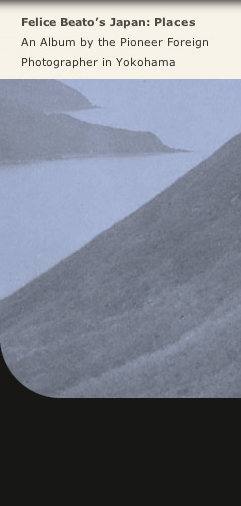
Album | Details
Scroll right to view all 50 images with captions transcribed verbatim from the ca. 1869 album.
Omissions due to length are indicated by an ellipsis.
Click here to go to the complete caption texts.
Scroll right to view all 50 images with captions transcribed verbatim from the ca. 1869 album.
Omissions due to length are indicated by an ellipsis.
Click here to go to the complete caption texts.
Beato album courtesy of Hood Museum of Art,
Dartmouth College Museum of Art
On viewing images from the historical record: click here
Massachusetts Institute of Technology © 2008 Visualizing Cultures
On viewing images from the historical record: click here
Massachusetts Institute of Technology © 2008 Visualizing Cultures
THE TOKAIDO, BETWEEN YOKOHAMA
AND FUJISAWA.
FROM Kanagawa to Fujisawa is a pleasant ride of five Japanese Ri, or about twelve and a half English miles, along the Tokaido, portions of the road are strikingly picturesque, and some beautiful views are obtained.
At Totska, a long straggling village about half way between the two places, there are some extraordinary Caves to be seen. Human labour has been in some places considerably used to alter and add to the originally natural form, and on the walls are some very peculiar frescoes of, it is said, very ancient date. These caves are about a mile from the road, and the villagers are always willing for a small consideration to act as guides to visitors, and provide torches for illuminating purposes. …
AND FUJISAWA.
FROM Kanagawa to Fujisawa is a pleasant ride of five Japanese Ri, or about twelve and a half English miles, along the Tokaido, portions of the road are strikingly picturesque, and some beautiful views are obtained.
At Totska, a long straggling village about half way between the two places, there are some extraordinary Caves to be seen. Human labour has been in some places considerably used to alter and add to the originally natural form, and on the walls are some very peculiar frescoes of, it is said, very ancient date. These caves are about a mile from the road, and the villagers are always willing for a small consideration to act as guides to visitors, and provide torches for illuminating purposes. …
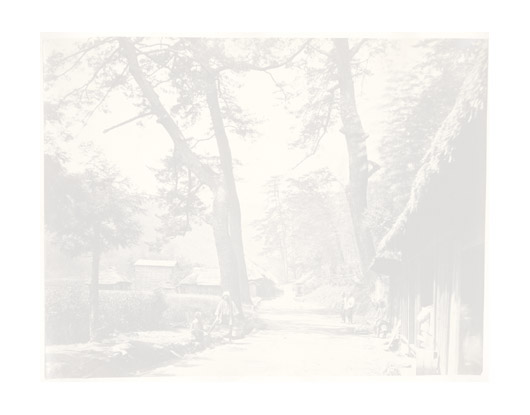
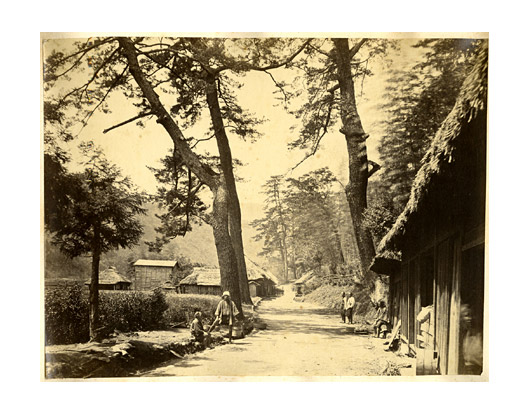
01
VIEW ON THE TOKAIDO.
THERE are five main roads which radiate from Yedo, whose ramifications, like arteries, spread over a large extent of the Island of Niphon. …
Of these main thoroughfares the Tokaido appears to be the one which merits most consideration, as being the principal highway, by which communication is facilitated between the largest cities of Japan, viz:—Osaka, the central commercial port of Japan; and Yedo which, up to the year 1865, was the residence of the Shiogun or Tycoon.
In the early years of the 17th century, one of the first foreign travellers thus remarks upon the Tokaido: — “on whatever side one turns his eye, he perceives a concourse of people passing to and fro, as in the most populous cities of Europe. The roads are lined on both sides with superb pine-trees, which keep off the sun. The distances are marked with little eminences planted with two trees."…
THERE are five main roads which radiate from Yedo, whose ramifications, like arteries, spread over a large extent of the Island of Niphon. …
Of these main thoroughfares the Tokaido appears to be the one which merits most consideration, as being the principal highway, by which communication is facilitated between the largest cities of Japan, viz:—Osaka, the central commercial port of Japan; and Yedo which, up to the year 1865, was the residence of the Shiogun or Tycoon.
In the early years of the 17th century, one of the first foreign travellers thus remarks upon the Tokaido: — “on whatever side one turns his eye, he perceives a concourse of people passing to and fro, as in the most populous cities of Europe. The roads are lined on both sides with superb pine-trees, which keep off the sun. The distances are marked with little eminences planted with two trees."…
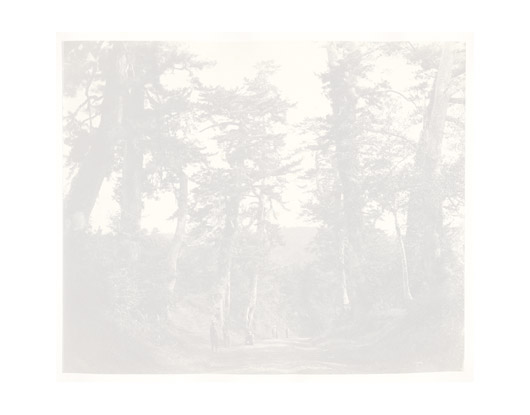
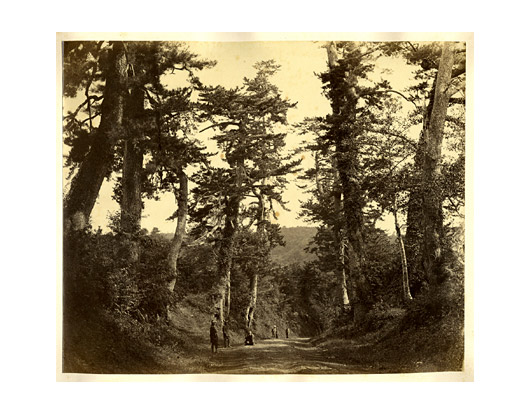
02
THE TOKAIDO.
THIS magnificent highway is attractive from being in many places one continued country lane—although a broad, level, well kept one—varied by having rows of thatched cottages on either side. It occasionally leads through populous towns, still however, with the same unpretending cottage bordering it. There is no traffic on the roads of a nature likely to cut them into ruts, or necessitate their frequent repair; there are no carriages, public or private, of any sort in Japan—no rattling teams of fast horses with heavy “Busses" behind them—no coaches with emulative whips trotting along at an exhilarating pace—such a profession as a Post boy is unknown! The echoes of the lovely dells, of which there are many on the Tokaido are never roused by the cheering sound of the Guard’s horn, the remembrance of which, still suggests to ancient lovers of the days of posting in England, the wish, that stage coaches in their glory had not been superseded by the rapid whirl of the railway engine—foot passengers and horses, shod alike with shoes made of straw, or coolies carrying goods or norimons or native chairs, are the only traffic taking wear or tear of any road. …
THIS magnificent highway is attractive from being in many places one continued country lane—although a broad, level, well kept one—varied by having rows of thatched cottages on either side. It occasionally leads through populous towns, still however, with the same unpretending cottage bordering it. There is no traffic on the roads of a nature likely to cut them into ruts, or necessitate their frequent repair; there are no carriages, public or private, of any sort in Japan—no rattling teams of fast horses with heavy “Busses" behind them—no coaches with emulative whips trotting along at an exhilarating pace—such a profession as a Post boy is unknown! The echoes of the lovely dells, of which there are many on the Tokaido are never roused by the cheering sound of the Guard’s horn, the remembrance of which, still suggests to ancient lovers of the days of posting in England, the wish, that stage coaches in their glory had not been superseded by the rapid whirl of the railway engine—foot passengers and horses, shod alike with shoes made of straw, or coolies carrying goods or norimons or native chairs, are the only traffic taking wear or tear of any road. …
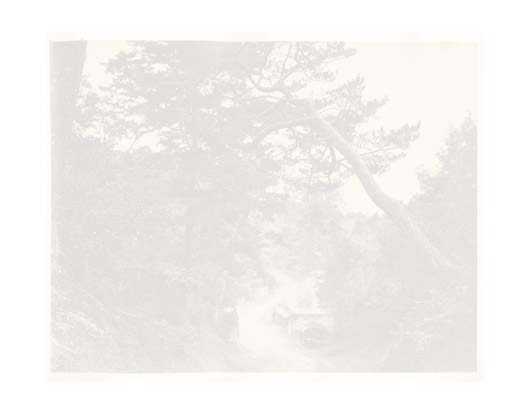
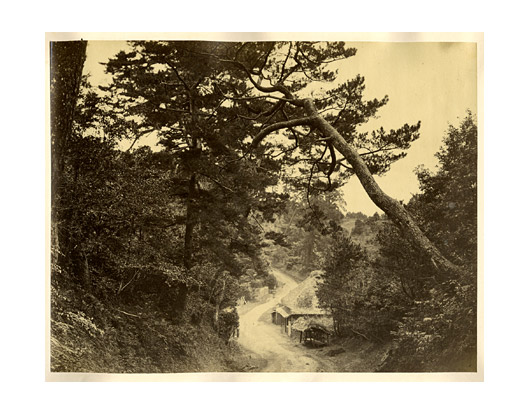
03
VALLEY OF MAYONASHI.
IRRESPECTIVE of the attractions of Mayonashi as a picturesque retreat among the hills, where bathing and trout fishing may be enjoyed, it has the advantage of being a good starting point for the sacred mountain of Oéyama—the highest of the range which encircles Fusi-yama—and from the summit of which a most extensive and comprehensive view of the neighbouring country may be obtained. Oéyama, like all other sacred mountains, is believed to have its guardian demon, yelept Tenjo—who is said to exhibit his displeasure by breaking the limbs of all who attempt to ascend on any side but the regular pathway taken by pilgrims—where tributary offerings are levied by attendant priests. As this road is closed to foreigners (with the exception of Ministerial Representatives), several parties of Foreigners—attracted by the charm of tasting forbidden fruit, have climbed its difficult height—and on one occasion an English officer, owing to having been misled by a guide, failed to attain the summit and accidentally broke his leg—which the natives looked upon as the demon’s revenge for invasion of his domain. …
IRRESPECTIVE of the attractions of Mayonashi as a picturesque retreat among the hills, where bathing and trout fishing may be enjoyed, it has the advantage of being a good starting point for the sacred mountain of Oéyama—the highest of the range which encircles Fusi-yama—and from the summit of which a most extensive and comprehensive view of the neighbouring country may be obtained. Oéyama, like all other sacred mountains, is believed to have its guardian demon, yelept Tenjo—who is said to exhibit his displeasure by breaking the limbs of all who attempt to ascend on any side but the regular pathway taken by pilgrims—where tributary offerings are levied by attendant priests. As this road is closed to foreigners (with the exception of Ministerial Representatives), several parties of Foreigners—attracted by the charm of tasting forbidden fruit, have climbed its difficult height—and on one occasion an English officer, owing to having been misled by a guide, failed to attain the summit and accidentally broke his leg—which the natives looked upon as the demon’s revenge for invasion of his domain. …
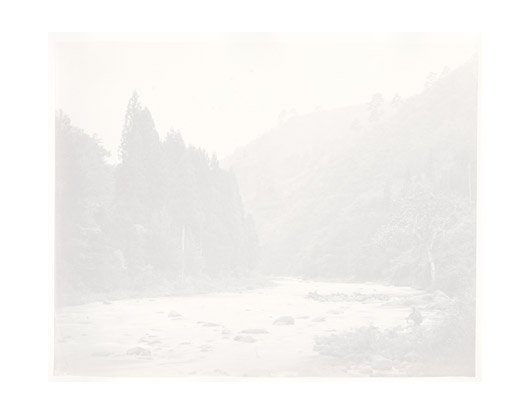
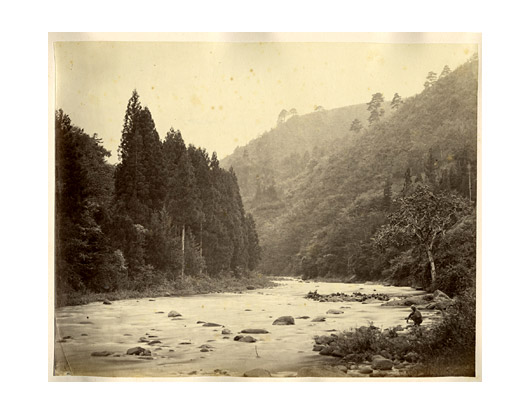
04
MAYONASHI.
OF all the beautiful rides within a fair days journey on horseback from Yokohama, none can exceed in charming attractiveness that to Mayonashi. This beautiful little spot, in a sequestered valley among the hills, is about 35 miles distant, and well repays a visit. The ride thither for the first twenty miles is through plain cultivated country, but after leaving Atchiungi, the scenery changes, and the last two hours of the ride is over a mountain from the summit of which a glorious view of the sea with Vries Island in the distance, may be obtained; soon after, a steep ascent brings the traveller to a village, where he can either take up his quarters in a temple or obtain accommodation at one of the neighbouring farm-houses. The river rushes along past the little village as clear as crystal, fringed with magnificent forest trees, alternately racing down rapids or in pools of from 15 to 20 feet deep, and with a pleasant musical roar or babble, soothing to hear. No pleasanter variety can well be imagined in Summer than a change from the heat and dust of Yokohama, to the cool shade of the river side at Mayonashi; no more delightful luxury than a plunge into its cool depths after the toils of business…
OF all the beautiful rides within a fair days journey on horseback from Yokohama, none can exceed in charming attractiveness that to Mayonashi. This beautiful little spot, in a sequestered valley among the hills, is about 35 miles distant, and well repays a visit. The ride thither for the first twenty miles is through plain cultivated country, but after leaving Atchiungi, the scenery changes, and the last two hours of the ride is over a mountain from the summit of which a glorious view of the sea with Vries Island in the distance, may be obtained; soon after, a steep ascent brings the traveller to a village, where he can either take up his quarters in a temple or obtain accommodation at one of the neighbouring farm-houses. The river rushes along past the little village as clear as crystal, fringed with magnificent forest trees, alternately racing down rapids or in pools of from 15 to 20 feet deep, and with a pleasant musical roar or babble, soothing to hear. No pleasanter variety can well be imagined in Summer than a change from the heat and dust of Yokohama, to the cool shade of the river side at Mayonashi; no more delightful luxury than a plunge into its cool depths after the toils of business…
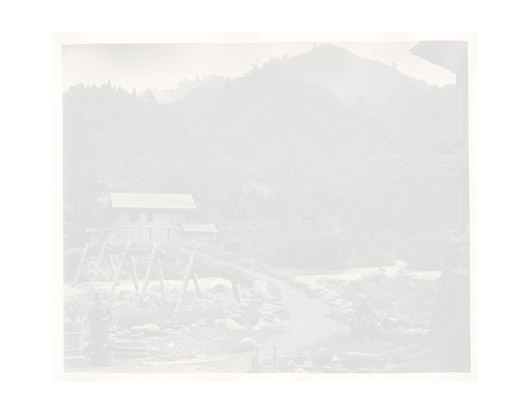
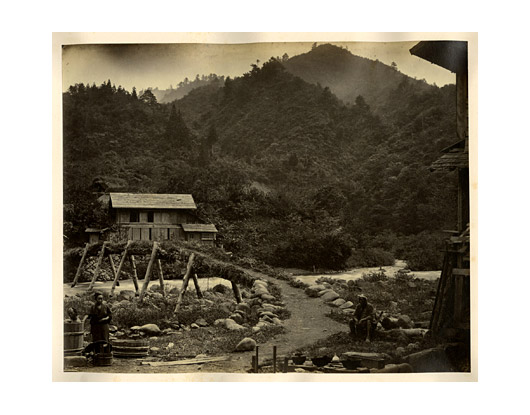
05
VIEW OF HAKONI VILLAGE.
AT the entrance to this—a true type of a street in a Japanese village—there is a Sékisho, or barrier gate. Any one passing is obliged to lift his hat, and by some this is supposed to be on account of the peculiar sanctity of the spot, but it is not so; the hat is lifted in order to enable the guard stationed at this barrier, which is on the boundary line between the territories of two different Daimios, to see the face of every individual so as to recognize him. Hakoni Lake is sacred, as are all mountains or lakes of extraordinary height in Japan. The mountains are believed to be inhabited by certain demons—the lakes by the dragons so frequently typified and worshipped, and which are supposed to have a powerful influence on the seasonable fall of rains. Hakoni Lake being one of, if not the highest lake in Niphon, is supposed to be the abode of the greatest dragon—and as besides, according to the Buddhist religion no one is allowed to fish in any lake, pool or pond which is sacred (or is adjacent to, or within the grounds of any Buddhist temple) the fish in this lake, though said to be plentiful are not allowed to be caught.
AT the entrance to this—a true type of a street in a Japanese village—there is a Sékisho, or barrier gate. Any one passing is obliged to lift his hat, and by some this is supposed to be on account of the peculiar sanctity of the spot, but it is not so; the hat is lifted in order to enable the guard stationed at this barrier, which is on the boundary line between the territories of two different Daimios, to see the face of every individual so as to recognize him. Hakoni Lake is sacred, as are all mountains or lakes of extraordinary height in Japan. The mountains are believed to be inhabited by certain demons—the lakes by the dragons so frequently typified and worshipped, and which are supposed to have a powerful influence on the seasonable fall of rains. Hakoni Lake being one of, if not the highest lake in Niphon, is supposed to be the abode of the greatest dragon—and as besides, according to the Buddhist religion no one is allowed to fish in any lake, pool or pond which is sacred (or is adjacent to, or within the grounds of any Buddhist temple) the fish in this lake, though said to be plentiful are not allowed to be caught.
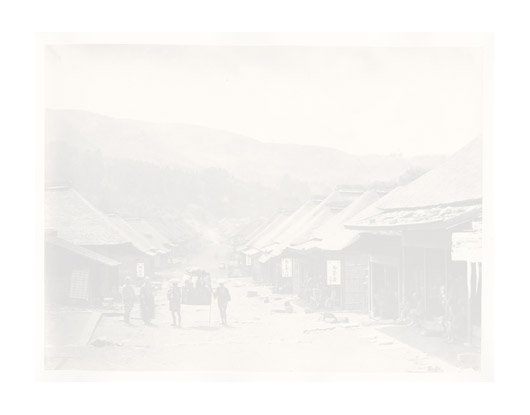
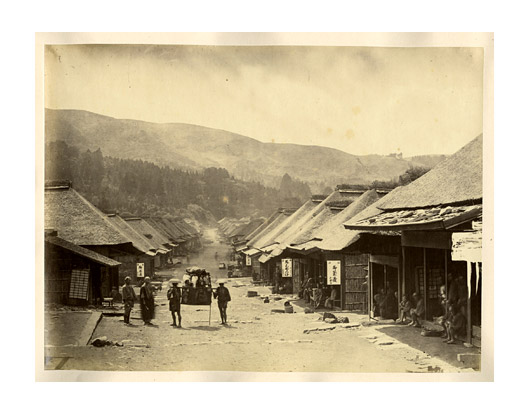
06
FUSI-YAMA, FROM MOORI-YAMA
THIS noble mountain, the highest in the Empire of Japan, is situated in the Island of Nipon, in the Province of Saruga, on the frontier of that of Kai. Its graceful pyramidal peak towers above the surrounding country, and is, according to the measurement of Lieutenant Robinson of the Indian Army, who visited it with Sir Rutherford Alcock, in 1861, 14,177 feet above the level of the sea, in Latitude 35.21 North, and Longitude 138.42 East.
In July and August, the only months of the year when its sufficiently free from snow to permit of the ascent, it is visited by numerous pilgrims, who flock to its cloud-enveloped shrines in crowds.
Daimios and persons of rank are said to believe it beneath their dignity to perform this pilgrimage; most of the pilgrims are therefore of the middle and lower classes. Their dress is peculiar and distinctive—it is of a white cotton material and is stamped with various mystic characters by the Bonzes, or priests, who for that purpose principally occupy the small temples round the crater during the season. …
THIS noble mountain, the highest in the Empire of Japan, is situated in the Island of Nipon, in the Province of Saruga, on the frontier of that of Kai. Its graceful pyramidal peak towers above the surrounding country, and is, according to the measurement of Lieutenant Robinson of the Indian Army, who visited it with Sir Rutherford Alcock, in 1861, 14,177 feet above the level of the sea, in Latitude 35.21 North, and Longitude 138.42 East.
In July and August, the only months of the year when its sufficiently free from snow to permit of the ascent, it is visited by numerous pilgrims, who flock to its cloud-enveloped shrines in crowds.
Daimios and persons of rank are said to believe it beneath their dignity to perform this pilgrimage; most of the pilgrims are therefore of the middle and lower classes. Their dress is peculiar and distinctive—it is of a white cotton material and is stamped with various mystic characters by the Bonzes, or priests, who for that purpose principally occupy the small temples round the crater during the season. …
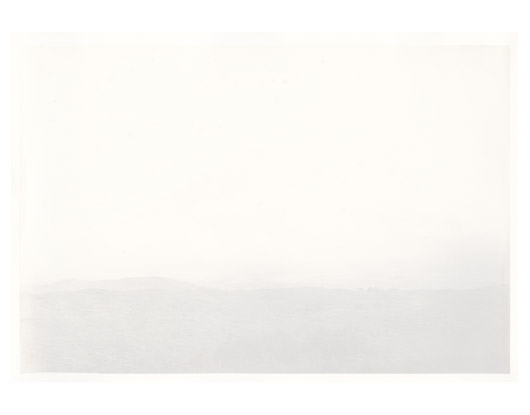
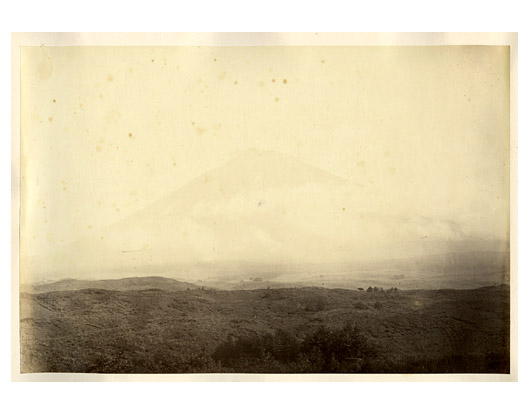
07
MIYANOSHITA.
THE village and Baths of Miyanoshita are situated in a charming valley in the bosom of the Hakoné mountains, at a considerable elevation above the level of the sea. The air is pure and bracing; a clear trout stream rushes down through the bottom of the valley; and altogether the invalid, the jaded man of business or the tourist, could nowhere find a locality better calculated than this to recruit his energies, or reward his search after the picturesque.
The view shows the village of Miyanoshita, with the peaks of the Hakoné mountains in the distance, and on the right the Shiro-ma-no Taki or White Horse Fall—an interesting cascade which tumbles from the mountain opposite the village down into the valley.
THE village and Baths of Miyanoshita are situated in a charming valley in the bosom of the Hakoné mountains, at a considerable elevation above the level of the sea. The air is pure and bracing; a clear trout stream rushes down through the bottom of the valley; and altogether the invalid, the jaded man of business or the tourist, could nowhere find a locality better calculated than this to recruit his energies, or reward his search after the picturesque.
The view shows the village of Miyanoshita, with the peaks of the Hakoné mountains in the distance, and on the right the Shiro-ma-no Taki or White Horse Fall—an interesting cascade which tumbles from the mountain opposite the village down into the valley.
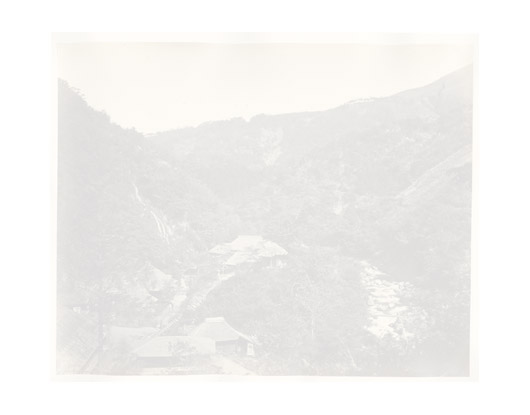
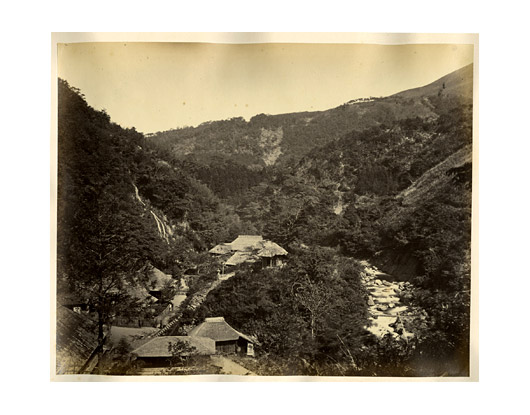
08
HAKONI LAKE.
THE first glimpse of this beautiful Mountain Loch, is not only extremely pretty, but is delightfully welcome to the weary traveller after ascending Hakoni Pass. He naturally wonders too, how this piece of placid looking water, about a mile and a half long by a mile wide, and said to be almost unfathomably deep, ever came to be where it is, some six or seven thousand feet above the level of the sea.
Hakoni Lake is surrounded by hills, bare, bleak and comfortless looking, ranging from two hundred to three hundred feet above the level of its surface, and frequently enveloped in a true Mountain Mist; it is surmised to be the crater of an extinct volcano, and abounds with fish of several kinds, and excellent quality.
The road up the Hakoni Pass from Odawara is in most places very steep, and paved with large round boulders, or slabs of stone, so smooth as to afford but an uncertain footing for horses, and necessitating the use of the straw shoes of the country. …
THE first glimpse of this beautiful Mountain Loch, is not only extremely pretty, but is delightfully welcome to the weary traveller after ascending Hakoni Pass. He naturally wonders too, how this piece of placid looking water, about a mile and a half long by a mile wide, and said to be almost unfathomably deep, ever came to be where it is, some six or seven thousand feet above the level of the sea.
Hakoni Lake is surrounded by hills, bare, bleak and comfortless looking, ranging from two hundred to three hundred feet above the level of its surface, and frequently enveloped in a true Mountain Mist; it is surmised to be the crater of an extinct volcano, and abounds with fish of several kinds, and excellent quality.
The road up the Hakoni Pass from Odawara is in most places very steep, and paved with large round boulders, or slabs of stone, so smooth as to afford but an uncertain footing for horses, and necessitating the use of the straw shoes of the country. …
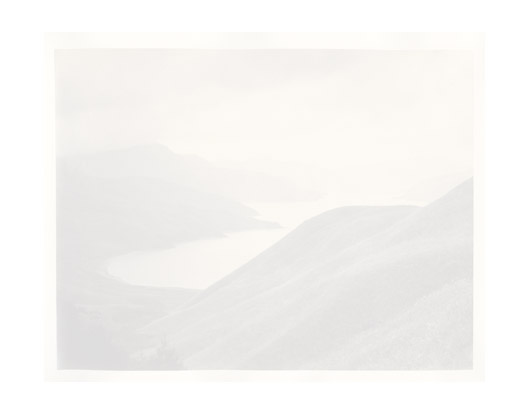
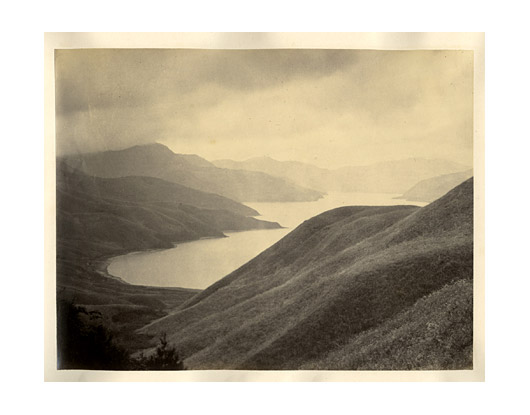
09
TEMPLE STREET, NATIVE TOWN, NAGASAKI.
THIS is one of the best and broadest of the eighty streets which the native town of Nagasaki is said to contain; it is nearly a mile in length, with a Pave running down the centre, formed of hard stone neatly laid—clean gravel or shingle forming the path on either side; the street terminates in a flight of steps, which disappears among the terraces that are in the grounds of a temple on the hill side, where the numerous tombstones are silent evidences of an extensive cemetery. The close proximity of these tombstones is remarkable, and is thus explained. Each person who is buried has to purchase a piece of ground in a cemetery—which becomes the property of himself and descendants—and as a high price is often asked by the priests, the smaller the piece of ground so obtained, the better it suits those of limited means—the custom of burning the dead is said to have originated in consequence of the necessity for purchasing ground for burial—the space occupied by a small earthen vessel containing the bones of and ashes of the dead, being considerably less than that required for a coffin.
THIS is one of the best and broadest of the eighty streets which the native town of Nagasaki is said to contain; it is nearly a mile in length, with a Pave running down the centre, formed of hard stone neatly laid—clean gravel or shingle forming the path on either side; the street terminates in a flight of steps, which disappears among the terraces that are in the grounds of a temple on the hill side, where the numerous tombstones are silent evidences of an extensive cemetery. The close proximity of these tombstones is remarkable, and is thus explained. Each person who is buried has to purchase a piece of ground in a cemetery—which becomes the property of himself and descendants—and as a high price is often asked by the priests, the smaller the piece of ground so obtained, the better it suits those of limited means—the custom of burning the dead is said to have originated in consequence of the necessity for purchasing ground for burial—the space occupied by a small earthen vessel containing the bones of and ashes of the dead, being considerably less than that required for a coffin.
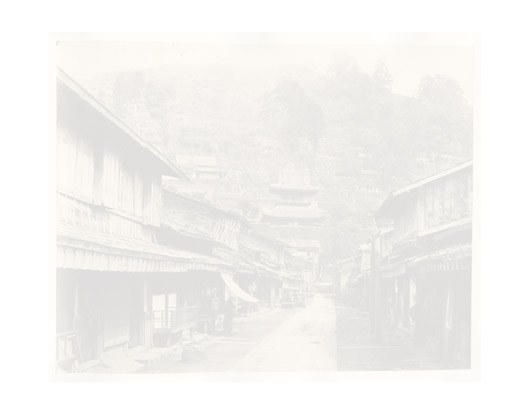
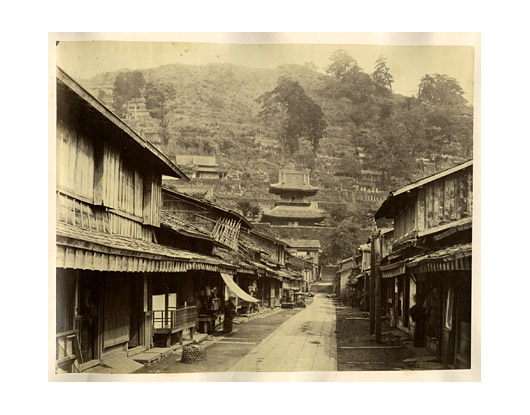
10
PAPPENBERG.
PLACED at the entrance to the harbour of Nagasaki, this picturesque little island at once attracts the attention of the new arrival; and its association with scenes of persecution, cruelty, and bloodshed, in the seventeenth century, when numerous Christians were hurled headlong down its precipitous sides, excites both awe and sympathy. To use the words of Sherard Osborn—“If history spoke true, there, by day and night its steep cliffs had rung with the agonized shrieks of strong men, or the wail of women and children, launched to rest, after torture, in the deep waters around the island. If Jesuit records are to be believed, the fortitude and virtue exhibited by their Japanese converts in those sad hours of affliction, have not been excelled in any part of the world, since religion gave another plea to man to destroy his fellow creature.”…
PLACED at the entrance to the harbour of Nagasaki, this picturesque little island at once attracts the attention of the new arrival; and its association with scenes of persecution, cruelty, and bloodshed, in the seventeenth century, when numerous Christians were hurled headlong down its precipitous sides, excites both awe and sympathy. To use the words of Sherard Osborn—“If history spoke true, there, by day and night its steep cliffs had rung with the agonized shrieks of strong men, or the wail of women and children, launched to rest, after torture, in the deep waters around the island. If Jesuit records are to be believed, the fortitude and virtue exhibited by their Japanese converts in those sad hours of affliction, have not been excelled in any part of the world, since religion gave another plea to man to destroy his fellow creature.”…
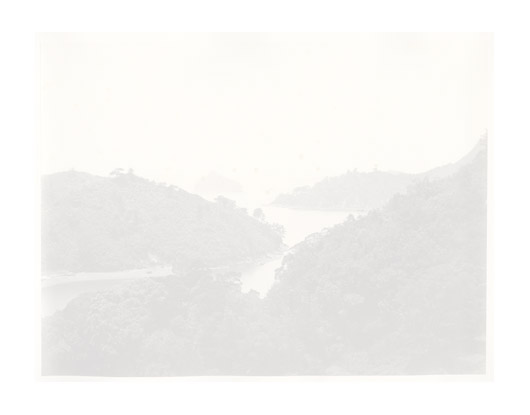
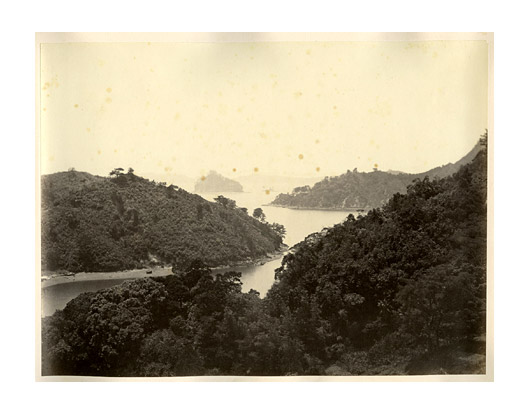
11
GARDEN AT HARRA.
As a people, the Japanese display a universal taste for gardens and love for flowers.
The specimen of ornamental gardening shown here is superior to many of the same description which may be met with in Japan. The owner was a man who early showed an inclination for the pursuit of horticulture, and though one of the labouring class, devoted all his spare time and means to collecting and cultivating the varieties of ornamental shrubs and indigenous flowers of his native country. His garden soon became an attraction and was visited by many; until at length the Tycoon himself, having heard of the spot, paid it a visit; and eventually, as a reward for the taste, ingenuity and perseverance displayed by the owner, raised him to the two sworded class—an honour by no means frequently conferred, and one specially valued.
The owner and a portion of his family are shown;—he is now mayor or chief of his ward in his native town of Harra.
As a people, the Japanese display a universal taste for gardens and love for flowers.
The specimen of ornamental gardening shown here is superior to many of the same description which may be met with in Japan. The owner was a man who early showed an inclination for the pursuit of horticulture, and though one of the labouring class, devoted all his spare time and means to collecting and cultivating the varieties of ornamental shrubs and indigenous flowers of his native country. His garden soon became an attraction and was visited by many; until at length the Tycoon himself, having heard of the spot, paid it a visit; and eventually, as a reward for the taste, ingenuity and perseverance displayed by the owner, raised him to the two sworded class—an honour by no means frequently conferred, and one specially valued.
The owner and a portion of his family are shown;—he is now mayor or chief of his ward in his native town of Harra.
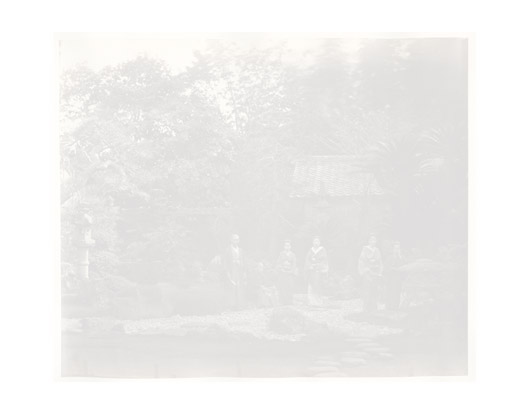
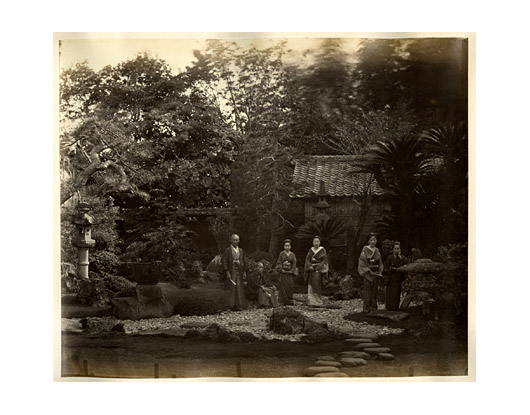
12
GARDEN AND HOUSE OF THE HIGH PRIEST OF FUSI-YAMA AT OMIA.
THE High Priest of Fusiyama is a Sintoo, and has charge and control over all the Sintoo Mias in the vicinity of the sacred mountain. He is not supported by the Government, but derives revenue from the voluntary subscriptions of the people, over whom he has ecclesiastical supervision—and of pilgrims who visit the mountain. The origin of the government support given to the Buddhist priesthood, and temples, dates from Gongen Sama, the founder of the Shogoon’s dynasty—who, meeting with many reverses during his wars, was frequently driven for refuge to the temples—the priesthood sheltered, and assisted him, by counsel and advice; and Yongen-sama in return promised an endowment to each temple which thus afforded him a temporary asylum—eventually when he became powerful and had subdued his opponents he fulfilled his promise, and from that time to the present date, the priesthood have continued to receive Government grants—generally in rice—said to be about fifty kokos on an average…
THE High Priest of Fusiyama is a Sintoo, and has charge and control over all the Sintoo Mias in the vicinity of the sacred mountain. He is not supported by the Government, but derives revenue from the voluntary subscriptions of the people, over whom he has ecclesiastical supervision—and of pilgrims who visit the mountain. The origin of the government support given to the Buddhist priesthood, and temples, dates from Gongen Sama, the founder of the Shogoon’s dynasty—who, meeting with many reverses during his wars, was frequently driven for refuge to the temples—the priesthood sheltered, and assisted him, by counsel and advice; and Yongen-sama in return promised an endowment to each temple which thus afforded him a temporary asylum—eventually when he became powerful and had subdued his opponents he fulfilled his promise, and from that time to the present date, the priesthood have continued to receive Government grants—generally in rice—said to be about fifty kokos on an average…
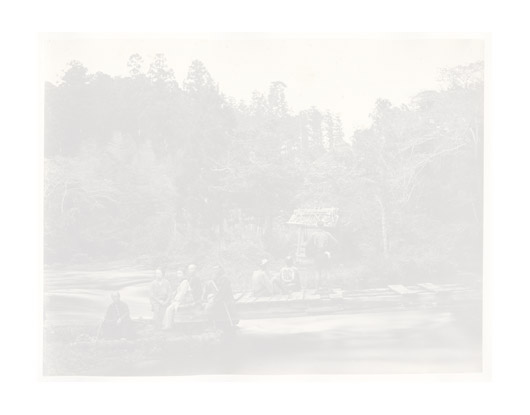
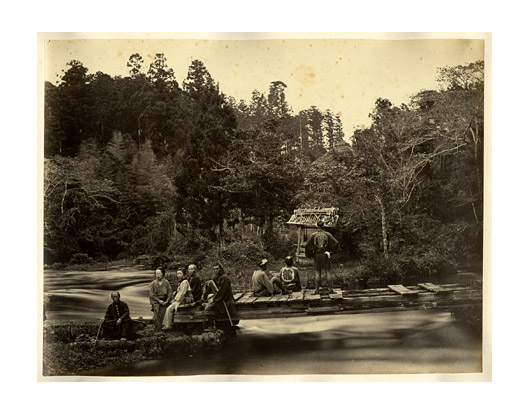
13
BRONZE STATUE OF JESO SAMA—HAKONI LAKE.
JESO SAMA, a god whose attributes are compassion and mercy, is believed by his worshippers, who are many, to be a guardian of the road to either Heaven or Hell—he is supposed to have the power of leading to the one, a place of happiness—and to arrest the course of those wandering to the other, a place of misery; hence the frequency with which his image is found by the wayside. The stone trough of water in front is for libations or offerings of water to the god. As a rule there is always a small vessel of stone for holding water at a short distance from all images; it being the invariable practice to wash the hands before offering a prayer to an image. The baldness is evidence of the god having been a priest before being canonized—and the excrescence on the forehead a proof of the frequency of bowing the head in prayer during lifetime. The heads of the Sintoo or Buddhist religion nominate individuals whose virtues or sanctity during life may have entitled them to the honour of being deified, and upon the Micado or Spiritual head signifying his approval to this recommendation, the individual or his image thenceforward becomes an object of worship. …
JESO SAMA, a god whose attributes are compassion and mercy, is believed by his worshippers, who are many, to be a guardian of the road to either Heaven or Hell—he is supposed to have the power of leading to the one, a place of happiness—and to arrest the course of those wandering to the other, a place of misery; hence the frequency with which his image is found by the wayside. The stone trough of water in front is for libations or offerings of water to the god. As a rule there is always a small vessel of stone for holding water at a short distance from all images; it being the invariable practice to wash the hands before offering a prayer to an image. The baldness is evidence of the god having been a priest before being canonized—and the excrescence on the forehead a proof of the frequency of bowing the head in prayer during lifetime. The heads of the Sintoo or Buddhist religion nominate individuals whose virtues or sanctity during life may have entitled them to the honour of being deified, and upon the Micado or Spiritual head signifying his approval to this recommendation, the individual or his image thenceforward becomes an object of worship. …
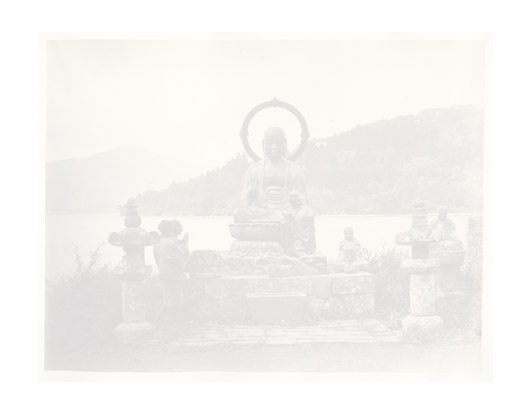
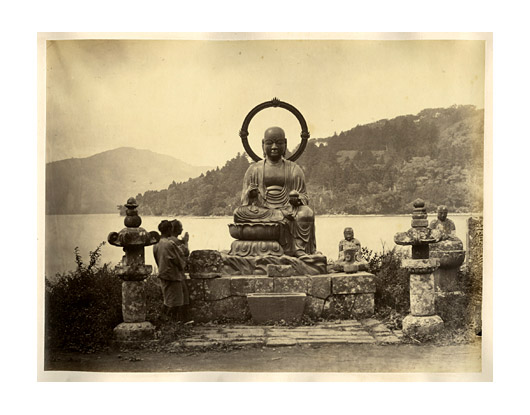
14
VIEW AT EIYAMA.
MOST strangers are struck by the neatness and order which prevail in the humblest cottage in Japan—and also by the extreme simplicity of the furniture—a few mats, which being about four inches thick, and made of rushes or straw are soft and pleasant to walk on—form the usual flooring, and except that the workmanship in those used in the Daimio’s palace, is superior to the cottar’s, there is little difference in the appearance or material used by all classes. Every mat is of the same size—viz, about 6 feet long by 3 broad—land is measured by mats.
The temple of the god, the palace of the prince, and the cottage of the peasant are alike also, with few exceptions, roofed with thatch; tiles are occasionally made use of, and also thin shavings of pine or cedar, not unlike shingles in America—but by far the greater proportion of all buildings are thatched, and the weight and thickness of some of the temple roofs, as well as the neatness of finish are particularly striking. Owing to the volcanic nature of the country, few houses are erected of more than one story high…
MOST strangers are struck by the neatness and order which prevail in the humblest cottage in Japan—and also by the extreme simplicity of the furniture—a few mats, which being about four inches thick, and made of rushes or straw are soft and pleasant to walk on—form the usual flooring, and except that the workmanship in those used in the Daimio’s palace, is superior to the cottar’s, there is little difference in the appearance or material used by all classes. Every mat is of the same size—viz, about 6 feet long by 3 broad—land is measured by mats.
The temple of the god, the palace of the prince, and the cottage of the peasant are alike also, with few exceptions, roofed with thatch; tiles are occasionally made use of, and also thin shavings of pine or cedar, not unlike shingles in America—but by far the greater proportion of all buildings are thatched, and the weight and thickness of some of the temple roofs, as well as the neatness of finish are particularly striking. Owing to the volcanic nature of the country, few houses are erected of more than one story high…
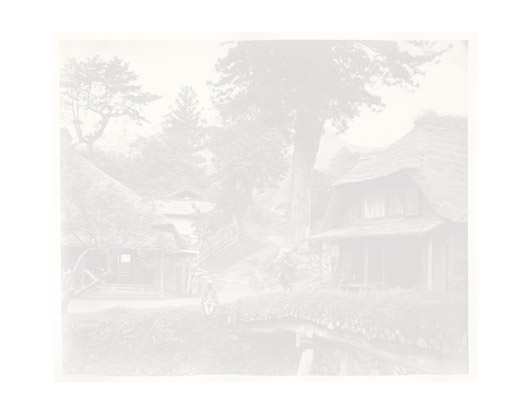
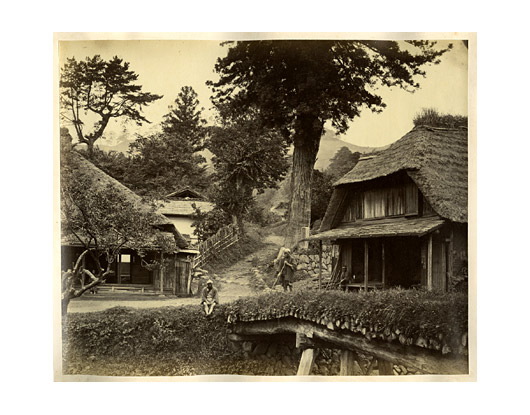
15
HARA—MATCHIDA.
THIS pretty little village, about three hours ride from Yokohama on the way to Hatchoji owes its rise and progress entirely to the increase and wealth of Yokohama. A few years ago, within the memory of most of the foreign residents, Hara-matchida was scarcely worthy of the name of a village; a stray house or two, occupied by farmers of a very humble class, was all that was to be seen of this now flourishing place. The rapid development of the silk trade, and the riches acquired by the merchants and middlemen who soon settled in this, as being a central spot—gradually spread their influence over the neighbourhood, and now, the substantial fire-proof godowns and growing importance of the place, have attracted a rapidly increasing population and are evidences of its substantial improvement.
There is a particularly clean and comfortable tea-house at Hara-machida for the accommodation of foreigners, and the inhabitants are always remarkably civil and obliging.
THIS pretty little village, about three hours ride from Yokohama on the way to Hatchoji owes its rise and progress entirely to the increase and wealth of Yokohama. A few years ago, within the memory of most of the foreign residents, Hara-matchida was scarcely worthy of the name of a village; a stray house or two, occupied by farmers of a very humble class, was all that was to be seen of this now flourishing place. The rapid development of the silk trade, and the riches acquired by the merchants and middlemen who soon settled in this, as being a central spot—gradually spread their influence over the neighbourhood, and now, the substantial fire-proof godowns and growing importance of the place, have attracted a rapidly increasing population and are evidences of its substantial improvement.
There is a particularly clean and comfortable tea-house at Hara-machida for the accommodation of foreigners, and the inhabitants are always remarkably civil and obliging.
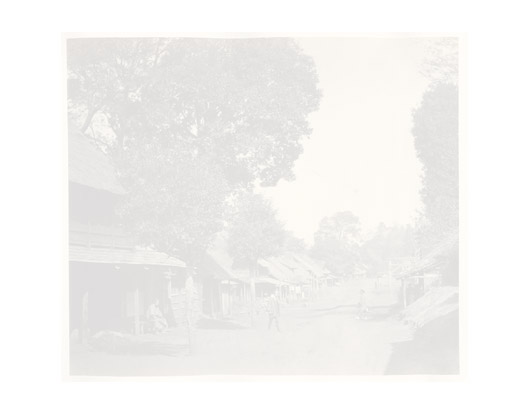
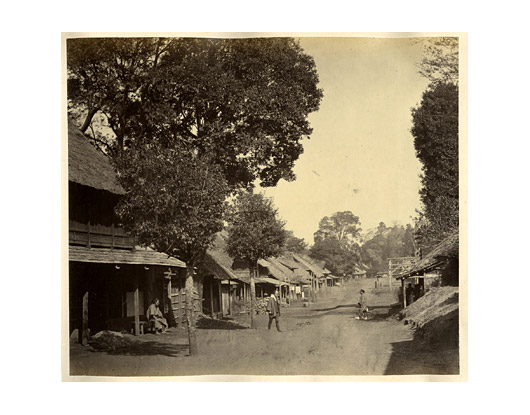
16
THE BRONZE STATUE OF DAI-BOUTS.
IN a pretty little grove, the avenue leading to it being lined with Camelias clipped rather formally, Oaks, Conifers, &c., and Azaleas also, which, when in blossom, about May, are very striking—this statue is placed. Inside the figure are numerous gilt images of Buddhist saints, shrines &c. The dimensions are, according to a description sold by the priest on the spot, as follows:—“The whole body is five jio’s (about 50 feet) high. The “height between the edge of the hair of the head and the legs, bent easily, being about 42 feet. The circumference of the body is 98 feet; the stone base 4 feet and a half high; the face 8 and a half in length, and 18 in breadth. The circular spot on the forehead is 1 foot and a half in circumference; the eyes 4 feet long; the eye-brows 4 feet 2 inches and a half long. the ear 6 feet 7 inches: the nose 3 feet 9 inches long and 2 feet 4 inches in breadth; the mouth 4 feet 3 inches and a half in circumference. …"
IN a pretty little grove, the avenue leading to it being lined with Camelias clipped rather formally, Oaks, Conifers, &c., and Azaleas also, which, when in blossom, about May, are very striking—this statue is placed. Inside the figure are numerous gilt images of Buddhist saints, shrines &c. The dimensions are, according to a description sold by the priest on the spot, as follows:—“The whole body is five jio’s (about 50 feet) high. The “height between the edge of the hair of the head and the legs, bent easily, being about 42 feet. The circumference of the body is 98 feet; the stone base 4 feet and a half high; the face 8 and a half in length, and 18 in breadth. The circular spot on the forehead is 1 foot and a half in circumference; the eyes 4 feet long; the eye-brows 4 feet 2 inches and a half long. the ear 6 feet 7 inches: the nose 3 feet 9 inches long and 2 feet 4 inches in breadth; the mouth 4 feet 3 inches and a half in circumference. …"
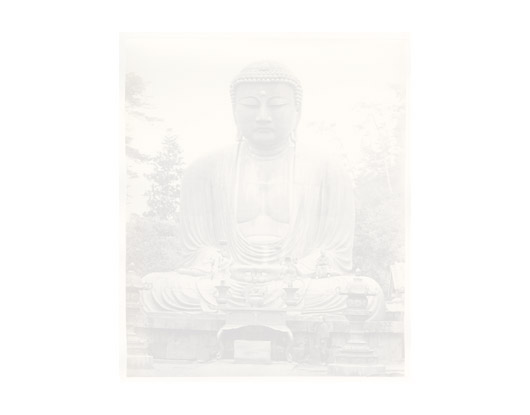
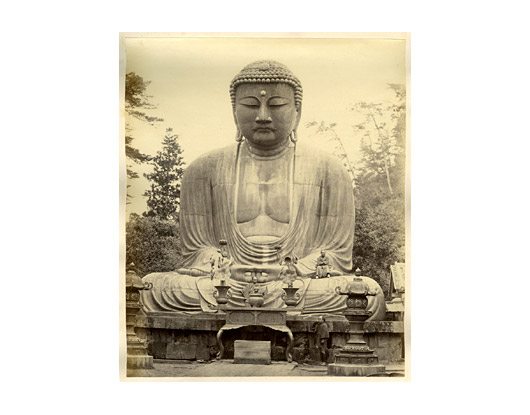
17
KAMAKURA.
THE origin of the name Kamakura or "District of the Sickle" being explained in another paper…it will be interesting to give the legendary account of its capture and destruction by Nita-Yoshi-sada. “In the year (A.D.) 1333 a powerful Daimio and great general Nita-Yoshi-sada at the head of twenty thousand cavalry, made a descent on Kamakura; and finding high hills well protected, roads dangerous and guarded by many thousands of armed men, and the beach obstructed by huge branches of trees, and flanked at a distance of one or two hundred yards by numerous war junks filled with archers, so that he could in no way approach the town—he dismounted from his charger, and taking off his helmet, prayed to Ryu-jin the God of the Ocean (who corresponds to Neptune in Western mythology); and at the same time, drawing his sword, richly ornamented with gold, he threw it into the waves.—Then wonderful to relate—the waves receded, and it became dry land to the distance of about two thousand yards! whereupon his army, each desiring to be first, marched without further impediment into the town of Kamakura, captured it and put the inhabitants to the sword. …”
THE origin of the name Kamakura or "District of the Sickle" being explained in another paper…it will be interesting to give the legendary account of its capture and destruction by Nita-Yoshi-sada. “In the year (A.D.) 1333 a powerful Daimio and great general Nita-Yoshi-sada at the head of twenty thousand cavalry, made a descent on Kamakura; and finding high hills well protected, roads dangerous and guarded by many thousands of armed men, and the beach obstructed by huge branches of trees, and flanked at a distance of one or two hundred yards by numerous war junks filled with archers, so that he could in no way approach the town—he dismounted from his charger, and taking off his helmet, prayed to Ryu-jin the God of the Ocean (who corresponds to Neptune in Western mythology); and at the same time, drawing his sword, richly ornamented with gold, he threw it into the waves.—Then wonderful to relate—the waves receded, and it became dry land to the distance of about two thousand yards! whereupon his army, each desiring to be first, marched without further impediment into the town of Kamakura, captured it and put the inhabitants to the sword. …”
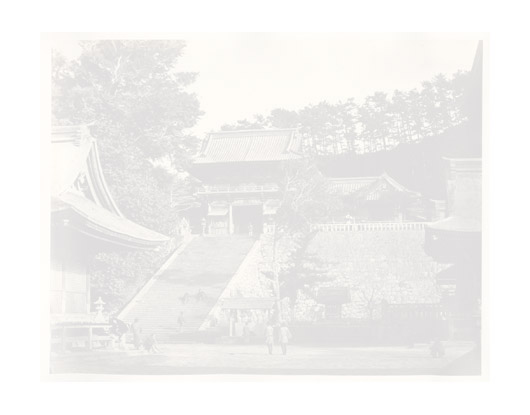
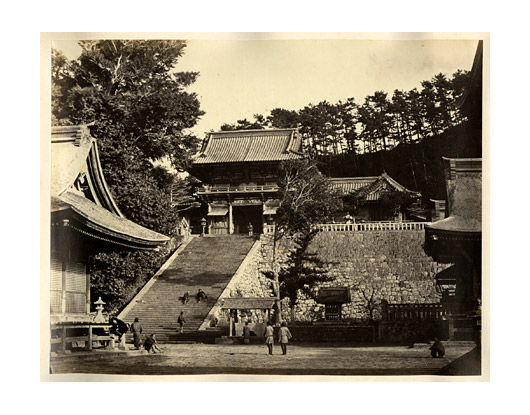
18
KAMAKURA.
THE entrance to these celebrated Temples, and the grounds in which they are situated, with their minor attractions are worthy of notice. Passing under a lofty portal, composed of two round pillars cut from a single block of granite on each side, slightly inclining inwards—into which the two ends of another straight slab of stone across the top are inserted, and surmounted by a simple concave cornice of the unvarying Japanese type which marks the entrance to all building or columns of a sacred character—the visitor crosses a bridge called the Akai-bashi, or "Red Bridge" which is peculiar from being entirely constructed of no other material than stone. This bridge divides a piece of water or pond, covered with the broad leaves of numerous Lotus plants, the flowers of which (white on one side and red on the other) are beautiful when in blossom. On a small Island in this pond there is a temple of Benten—and on its surface, and round its edges, numerous sacred cranes, and wild duck of varied plumage, disport themselves unmolested.
THE entrance to these celebrated Temples, and the grounds in which they are situated, with their minor attractions are worthy of notice. Passing under a lofty portal, composed of two round pillars cut from a single block of granite on each side, slightly inclining inwards—into which the two ends of another straight slab of stone across the top are inserted, and surmounted by a simple concave cornice of the unvarying Japanese type which marks the entrance to all building or columns of a sacred character—the visitor crosses a bridge called the Akai-bashi, or "Red Bridge" which is peculiar from being entirely constructed of no other material than stone. This bridge divides a piece of water or pond, covered with the broad leaves of numerous Lotus plants, the flowers of which (white on one side and red on the other) are beautiful when in blossom. On a small Island in this pond there is a temple of Benten—and on its surface, and round its edges, numerous sacred cranes, and wild duck of varied plumage, disport themselves unmolested.
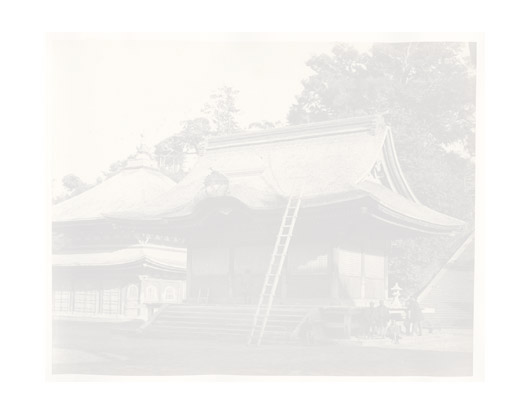
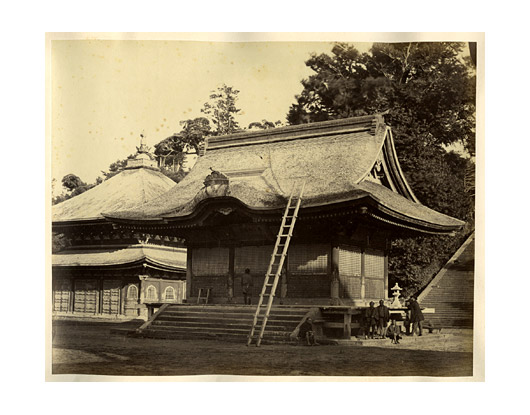
19
KAMAKURA—TEMPLE OF HATCHIMAN.
IN about the year 717—724, the great grandson of Kamatari made Kamakura his residence. In 1057 Iyo-no-kame Yobi-yoshi the ruling General or Shogun, having conquered North Sendai, became Duke or Lord of Sagami, and soon after removed a temple from Yamashibo near Kioto to Yu-i.—His Son Hatchiman-toro-Yoshie who was born A. D. 1091 succeeded to the office of Shogun who took up his residence at Kamakura. In 1177, Yoritomo a very popular national hero, and one whose memory is much revered, removed the above mentioned temple of Yu-i to the site of the buried Sickle of Kamatari and named it Hatchiman, whice name it has since borne. He also made Kamakura his Capital, and from that time until its capture and destruction by Nita Yoshi Sada, A. D. 1333, it was an extensive, populous, and by all accounts, beautiful metropolis. It is now merely an insignificant village with no signs of its past greatness but its temples and its traditions. Yoritimo died A. D. 1200 and was buried at Kamakura, where his tomb, an unpretending one, may still be seen.
IN about the year 717—724, the great grandson of Kamatari made Kamakura his residence. In 1057 Iyo-no-kame Yobi-yoshi the ruling General or Shogun, having conquered North Sendai, became Duke or Lord of Sagami, and soon after removed a temple from Yamashibo near Kioto to Yu-i.—His Son Hatchiman-toro-Yoshie who was born A. D. 1091 succeeded to the office of Shogun who took up his residence at Kamakura. In 1177, Yoritomo a very popular national hero, and one whose memory is much revered, removed the above mentioned temple of Yu-i to the site of the buried Sickle of Kamatari and named it Hatchiman, whice name it has since borne. He also made Kamakura his Capital, and from that time until its capture and destruction by Nita Yoshi Sada, A. D. 1333, it was an extensive, populous, and by all accounts, beautiful metropolis. It is now merely an insignificant village with no signs of its past greatness but its temples and its traditions. Yoritimo died A. D. 1200 and was buried at Kamakura, where his tomb, an unpretending one, may still be seen.
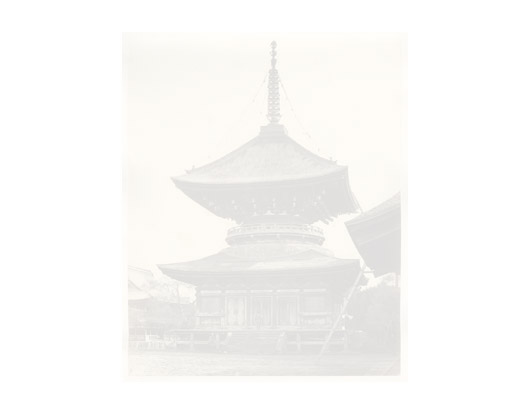
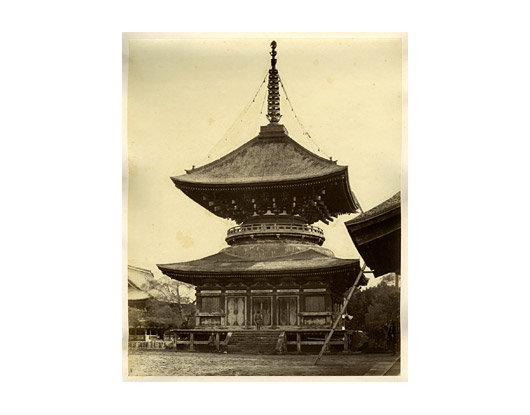
20
KAMAKURA—TEMPLE OF HATCHIMAN.
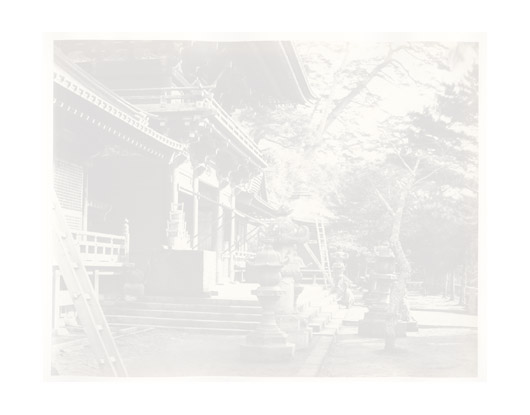
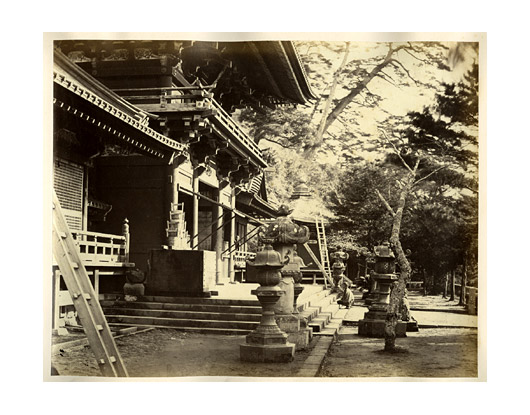
21
MAIN STREET OF KANAGAWA.
In Kanagawa the Consuls of the Treaty Powers were located when the ports were first opened to Foreign trade in 1859. Temples were assigned to their use, and there they resided until the growing importance of Yokohama, which is on the opposite side of the bay, necessitated their removal.
The town of Kanagawa is one long street or rather, it is a considerable village, with the Tokaido running through it. There are numerous tea houses and way side inns; as, being at a distance of about sixteen to eighteen miles from Yeddo, it is generally the halting place for travelers for the night previous to arriving at, or after leaving, the capital. In former days the Dutch as a rule halted at Kanagawa as their last stage on the way to Yedo. The shops however are inconsiderable in size, and the tea houses by no means so good as are frequently met with on other parts of the Tokaido. …
In Kanagawa the Consuls of the Treaty Powers were located when the ports were first opened to Foreign trade in 1859. Temples were assigned to their use, and there they resided until the growing importance of Yokohama, which is on the opposite side of the bay, necessitated their removal.
The town of Kanagawa is one long street or rather, it is a considerable village, with the Tokaido running through it. There are numerous tea houses and way side inns; as, being at a distance of about sixteen to eighteen miles from Yeddo, it is generally the halting place for travelers for the night previous to arriving at, or after leaving, the capital. In former days the Dutch as a rule halted at Kanagawa as their last stage on the way to Yedo. The shops however are inconsiderable in size, and the tea houses by no means so good as are frequently met with on other parts of the Tokaido. …
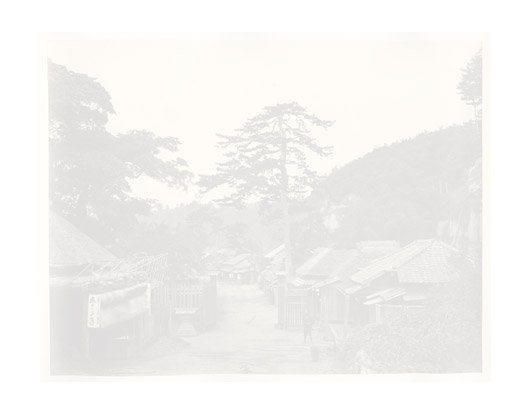
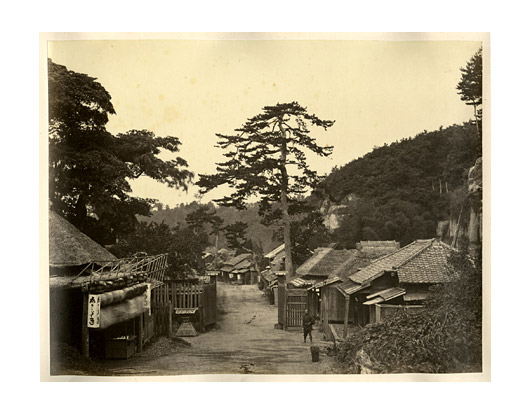
22
VIEW ON THE NEW ROAD—MISSISSIPPI BAY.
WHATEVER may have been the motives which induced the Japanese to construct the New Road is scarcely worth an enquiry. That the road, however, is a comfort and a luxury to the Foreign residents of Yokohama cannot be questioned. It was completed in 1866, and is about six miles in length, winding through a varied, undulating and pretty country. The view from the hill overlooking Mississippi Bay, which this road also skirts, is particularly attractive. About a year after the opening of the New Road a Race Course, over a mile in circumference, well laid out, well constructed and on a beautiful site adjoining the road, was with considerable labour completed. Commanding, as it does from the stand, a view, which, for richness and extent, can scarcely be excelled and seldom equaled, it will be considered—if not the finest—one of the best courses in this part of the world. …
WHATEVER may have been the motives which induced the Japanese to construct the New Road is scarcely worth an enquiry. That the road, however, is a comfort and a luxury to the Foreign residents of Yokohama cannot be questioned. It was completed in 1866, and is about six miles in length, winding through a varied, undulating and pretty country. The view from the hill overlooking Mississippi Bay, which this road also skirts, is particularly attractive. About a year after the opening of the New Road a Race Course, over a mile in circumference, well laid out, well constructed and on a beautiful site adjoining the road, was with considerable labour completed. Commanding, as it does from the stand, a view, which, for richness and extent, can scarcely be excelled and seldom equaled, it will be considered—if not the finest—one of the best courses in this part of the world. …
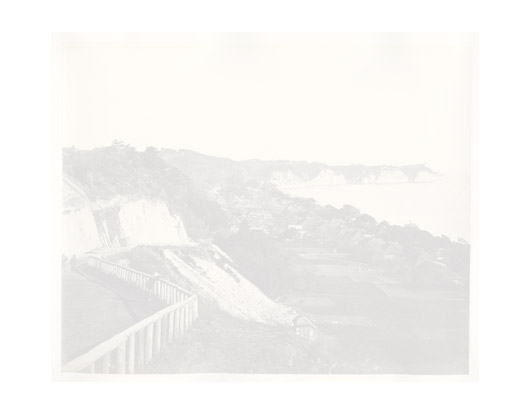
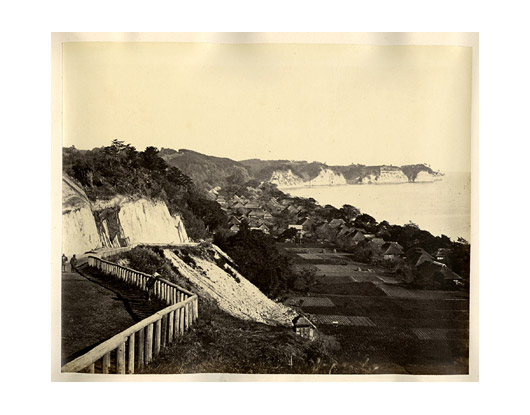
23
VIEW NEAR KAMAKURA WHERE MAJOR BALDWIN AND LIEUT. BIRD WERE MURDERED.
… On the 21st November 1864, Major George Walter Baldwin and Lieutenant Robert Nicholas Bird—both of the 2nd Battallion H.B.M. XX Regiment, left Yokohama on horseback for a visit to Kamakura and its neighbourhood. After going as far as Inosima, where they breakfasted with Mr. Beato and some other excursionists, they left about noon with the intention of visiting Daiboots; while crossing the little stone bridge shewn in the picture opposite, they were attacked from behind, and cut down before they had an opportunity of defending themselves, or drawing the revolvers with which they were both armed. …several parties of foreigners, and a detachment of mounted Artillery, at once proceeded to the spot; and found the bodies of the unfortunate officers under a small shed covered with mats—the only information that could be elicited from the natives was, that the younger officer had lived for some hours after being cut down, and the elder, Major Baldwin, had been killed at once. …
… On the 21st November 1864, Major George Walter Baldwin and Lieutenant Robert Nicholas Bird—both of the 2nd Battallion H.B.M. XX Regiment, left Yokohama on horseback for a visit to Kamakura and its neighbourhood. After going as far as Inosima, where they breakfasted with Mr. Beato and some other excursionists, they left about noon with the intention of visiting Daiboots; while crossing the little stone bridge shewn in the picture opposite, they were attacked from behind, and cut down before they had an opportunity of defending themselves, or drawing the revolvers with which they were both armed. …several parties of foreigners, and a detachment of mounted Artillery, at once proceeded to the spot; and found the bodies of the unfortunate officers under a small shed covered with mats—the only information that could be elicited from the natives was, that the younger officer had lived for some hours after being cut down, and the elder, Major Baldwin, had been killed at once. …
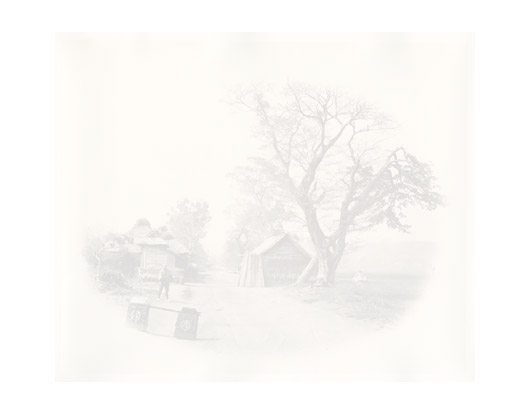
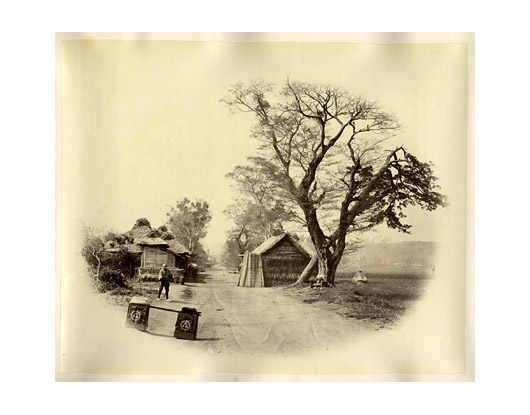
24
GREAT BELL AT THE TEMPLE OF KOBO-DAISHI NEAR KAWASAKI.
KAWASAKI is the boundary within which Foreigners are at present confined in the Yedo direction. At the ferry there is a guard of Japanese Yakonins stationed, for the purpose of preventing persons unprovided with a passport, or unaccompanied by an escort from the Custom House at Yokohama from crossing the river Logo. An interesting object in the vicinity of Kawasaki, distant about a mile or a mile and a half from the tea house where travelers generally halt, is a Temple of Kobo-Daishi, a Buddhist Saint, who has the reputation of having invented the Japanese Alphabet, and who is prayed to for protection from misfortunes—The road to this temple which is mostly paved with blocks of stone, winds principally through paddy fields, though it is occasionally bordered on either side by Orchards, where pear trees may be noticed carefully trained over trellis work about six feet from the ground. The pears grown in this neighbourhood are said to be particularly fine. …
KAWASAKI is the boundary within which Foreigners are at present confined in the Yedo direction. At the ferry there is a guard of Japanese Yakonins stationed, for the purpose of preventing persons unprovided with a passport, or unaccompanied by an escort from the Custom House at Yokohama from crossing the river Logo. An interesting object in the vicinity of Kawasaki, distant about a mile or a mile and a half from the tea house where travelers generally halt, is a Temple of Kobo-Daishi, a Buddhist Saint, who has the reputation of having invented the Japanese Alphabet, and who is prayed to for protection from misfortunes—The road to this temple which is mostly paved with blocks of stone, winds principally through paddy fields, though it is occasionally bordered on either side by Orchards, where pear trees may be noticed carefully trained over trellis work about six feet from the ground. The pears grown in this neighbourhood are said to be particularly fine. …
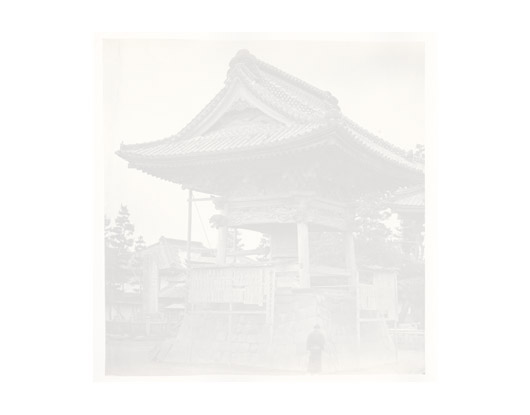
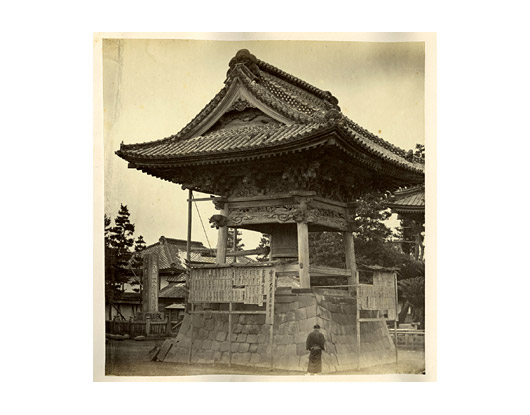
25
YEDO BAY.
AFTER crossing the Logo, a ride of about three quarters of an hour brings the traveller in sight of what may be regarded as the entrance to Yedo, which lies encircling the head of a sickle shaped bay, with the small insular forts to the right, and many houses and temples, and gradually ascending heights well besprinkled with stately trees to the left, the suburb of Sinagawa, of questionable repute, is passed and the English Legation which lies close to the waters edge is reached. The meaning of the word Yedo is “River Mouth"—the bay itself is so shallow that large vessels cannot approach within three or four miles, and the view of it from the water scarcely gives the spectator an idea of its enormous extent, for its suburbs spread over a space of some twenty miles and are densely populated. Few capitals can boast so many striking features or so much beauty in its site and its surrounding country as this, for many leagues in every direction—and the charming rides through country lanes, even its very centre, shaded as they often are by trees of magnificent growth, from attractions which are unrivalled by any western city of corresponding size. …
AFTER crossing the Logo, a ride of about three quarters of an hour brings the traveller in sight of what may be regarded as the entrance to Yedo, which lies encircling the head of a sickle shaped bay, with the small insular forts to the right, and many houses and temples, and gradually ascending heights well besprinkled with stately trees to the left, the suburb of Sinagawa, of questionable repute, is passed and the English Legation which lies close to the waters edge is reached. The meaning of the word Yedo is “River Mouth"—the bay itself is so shallow that large vessels cannot approach within three or four miles, and the view of it from the water scarcely gives the spectator an idea of its enormous extent, for its suburbs spread over a space of some twenty miles and are densely populated. Few capitals can boast so many striking features or so much beauty in its site and its surrounding country as this, for many leagues in every direction—and the charming rides through country lanes, even its very centre, shaded as they often are by trees of magnificent growth, from attractions which are unrivalled by any western city of corresponding size. …
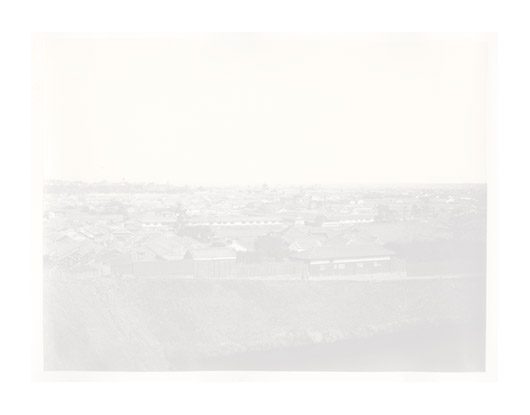
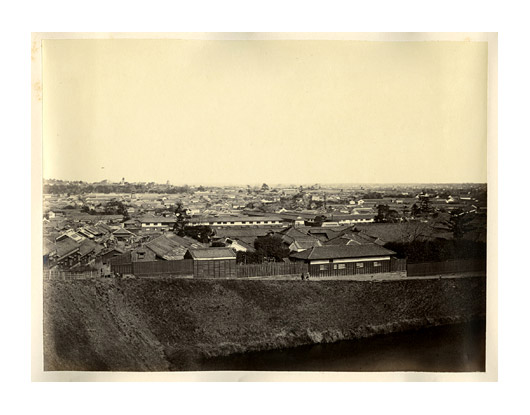
26
THERE are facts connected with this picturesque spot not generally known, but which are peculiarly interesting.
First—By this Bell time is regulated in one of the central districts of the populous capital, Yedo. The hours being struck day and night throughout the year.
Second—To support the men who are always employed—and to keep up this establishment, a tax—collected once a year—is levied on the householders within a radius of 8 Japanese cho …
Third—The mode of computing Japanese time as compared with the hours as recorded by the clocks or chronometers of western countries which is as follows:
The Japanese day and night are divided into six hours each, that is six hours between sunrise and sunset and six hours between sunset and sunrise—it follows therefore that only at the Vernal Equinox on 21st March, and Autumnal Equinox on 23rd September in each year are the hours of equal length, and on every other day of the year a small diminution in the length of the hours of the day with a proportionate increase in the length of the hours of the night—or vice versa, naturally occurs; an elaborate complication in the daily calculation of time which is met by the peculiar construction of their clocks. …
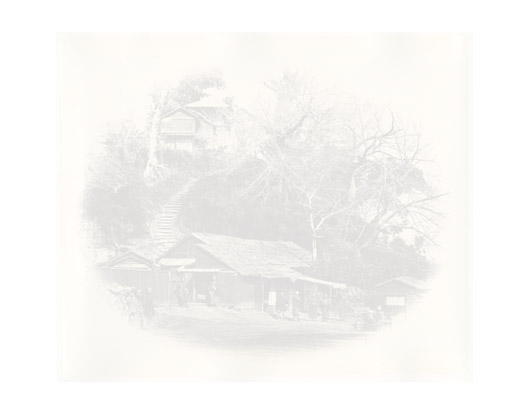
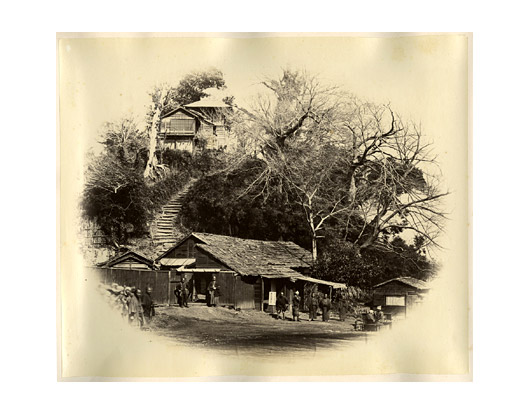
27
SATSUMA’S PALACE—YEDO.
MORE than ordinary interest has been attracted to this spot by the tragedy there enacted on the 19th January 1868. … It appears that a band of robbers or Lonins which had been giving considerable trouble in and about Yedo, were traced to Satsuma’s Yashikis, and a messenger was sent demanding that these men should be delivered up to justice. The messenger was beheaded—and a detachment of Tycoon’s troops which accompanied him was fired upon. Four Yashikis of Satsuma were immediately surrounded by troops and a scene of destruction and bloodshed followed dreadful to think of. Men women and children were swept away by artillery, and the houses burnt over their heads. The official account acknowledges to the death of between 50 or 60 robbers (and 260 prisoners were captured), but if this number were killed of the temporary occupants, who were only taking refuge within the Yashikis of Satsuma, how many of the families of his retainers who permanently resided within their walls were destroyed, can scarcely be now told. …
MORE than ordinary interest has been attracted to this spot by the tragedy there enacted on the 19th January 1868. … It appears that a band of robbers or Lonins which had been giving considerable trouble in and about Yedo, were traced to Satsuma’s Yashikis, and a messenger was sent demanding that these men should be delivered up to justice. The messenger was beheaded—and a detachment of Tycoon’s troops which accompanied him was fired upon. Four Yashikis of Satsuma were immediately surrounded by troops and a scene of destruction and bloodshed followed dreadful to think of. Men women and children were swept away by artillery, and the houses burnt over their heads. The official account acknowledges to the death of between 50 or 60 robbers (and 260 prisoners were captured), but if this number were killed of the temporary occupants, who were only taking refuge within the Yashikis of Satsuma, how many of the families of his retainers who permanently resided within their walls were destroyed, can scarcely be now told. …


28
TEA HOUSES AT OGEE—YEDO.
To use the words of Fortune “Ogee is the Richmond of Japan, and its celebrated tea-house is a sort of ‘Star and Garter Hotel,’ here the good citizens of Yedo come out for a days pleasure and recreation, and certainly it would be difficult to find a spot more lovely or more enjoyable." There is a garden, as is usual at all the places of resort for pleasure seekers, and a running stream overhung with branches of trees and lovely flowers, just in rear of the tea house. The hunting grounds of the Tycoon are in the vicinity—a place formerly used for Hawking, and also an Archery ground for the Imperial soldiers, as well as a special refectory for preparing a repast for the retinue of the Tycoon whenever it may suit his Majesty to visit this spot. From the height near Ogee the spectator has a magnificent view of well wooded country, interspersed with richly cultivated fields—and taking the place as a whole, a pleasanter or more delightful spot for a days jaunt, cannot well be imagined.
To use the words of Fortune “Ogee is the Richmond of Japan, and its celebrated tea-house is a sort of ‘Star and Garter Hotel,’ here the good citizens of Yedo come out for a days pleasure and recreation, and certainly it would be difficult to find a spot more lovely or more enjoyable." There is a garden, as is usual at all the places of resort for pleasure seekers, and a running stream overhung with branches of trees and lovely flowers, just in rear of the tea house. The hunting grounds of the Tycoon are in the vicinity—a place formerly used for Hawking, and also an Archery ground for the Imperial soldiers, as well as a special refectory for preparing a repast for the retinue of the Tycoon whenever it may suit his Majesty to visit this spot. From the height near Ogee the spectator has a magnificent view of well wooded country, interspersed with richly cultivated fields—and taking the place as a whole, a pleasanter or more delightful spot for a days jaunt, cannot well be imagined.
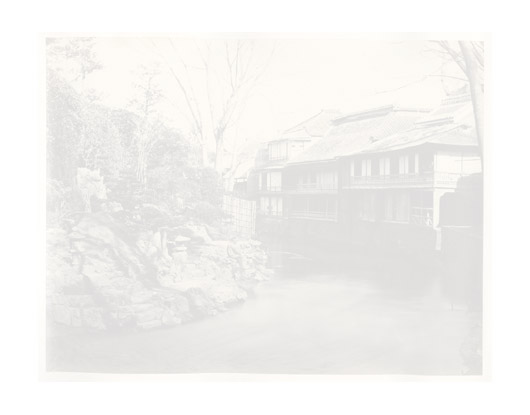
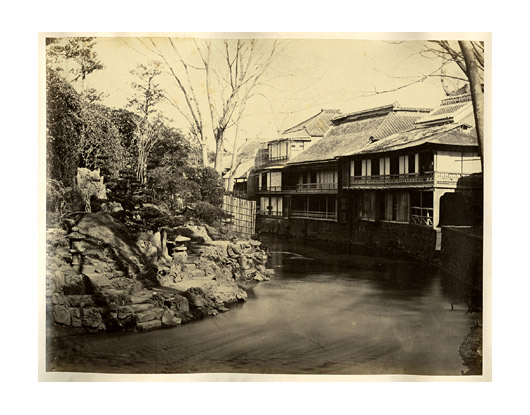
29
BURIAL GROUND OF THE TAIKUNS.
THE Taikuns of the dynasty founded by Iyeyas are all buried either at Shiba or at Uyeno, in Yedo, with the exception of Iyeyasu himself. The view represents the gateway and front of a small, but highly finished temple or shrine immediately behind the main temple in the centre of the burial ground at Shiba. This small temple is erected to Kuro-hou-zou, or the “Black true Buddha,” who, according to the legend, came to the aid of Iyeyasu on one occasion when he was on the point of being overwhelmed by his enemies. Our guide, when showing us through these grounds, informed us, in his imperfect English, that it was a temple to the “good God.” The doors, both outside and inside are exquisitely coloured and gilded, and covered with carvings of peacocks and other birds, all in the natural hues of their plumage. The gateway, as well as the whole front and sides of the temple, are similarly ornamented.
THE Taikuns of the dynasty founded by Iyeyas are all buried either at Shiba or at Uyeno, in Yedo, with the exception of Iyeyasu himself. The view represents the gateway and front of a small, but highly finished temple or shrine immediately behind the main temple in the centre of the burial ground at Shiba. This small temple is erected to Kuro-hou-zou, or the “Black true Buddha,” who, according to the legend, came to the aid of Iyeyasu on one occasion when he was on the point of being overwhelmed by his enemies. Our guide, when showing us through these grounds, informed us, in his imperfect English, that it was a temple to the “good God.” The doors, both outside and inside are exquisitely coloured and gilded, and covered with carvings of peacocks and other birds, all in the natural hues of their plumage. The gateway, as well as the whole front and sides of the temple, are similarly ornamented.
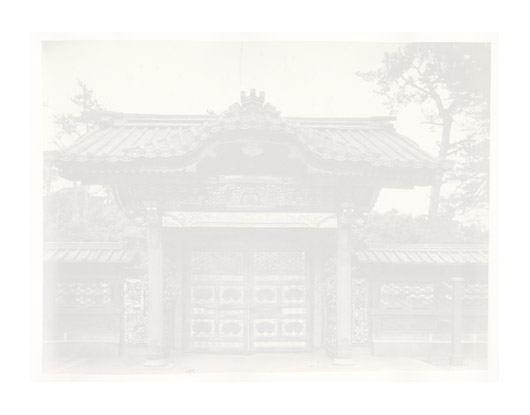
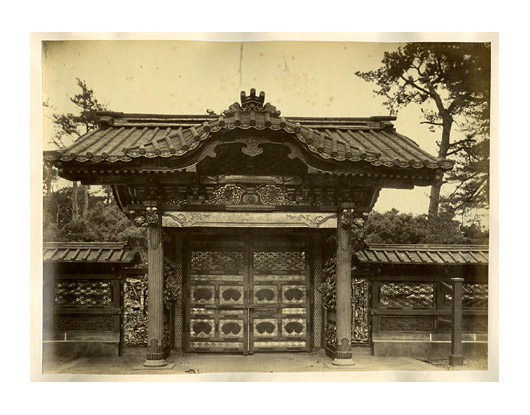
30
BURIAL GROUND OF THE TAIKUNS.
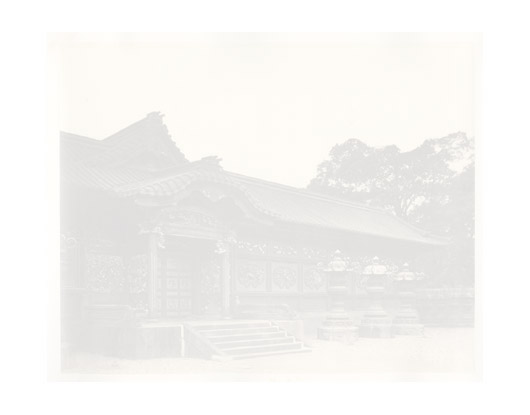
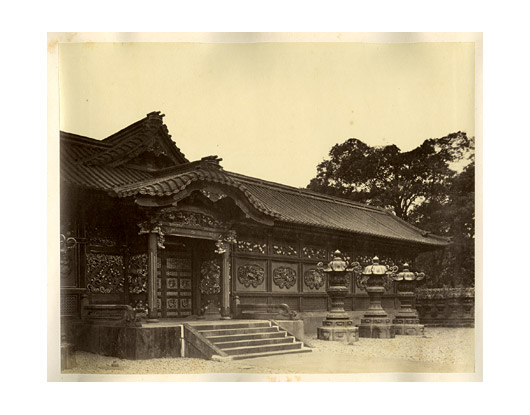
31
BURIAL GROUND OF THE TAIKUNS.
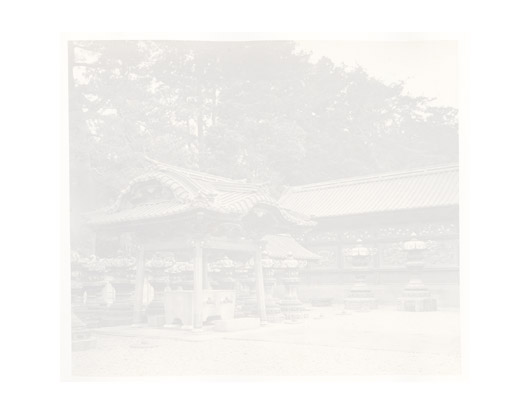
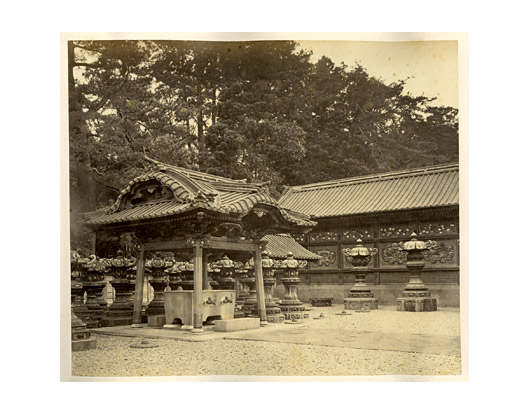
32
BURIAL GROUND OF THE TAIKUNS.
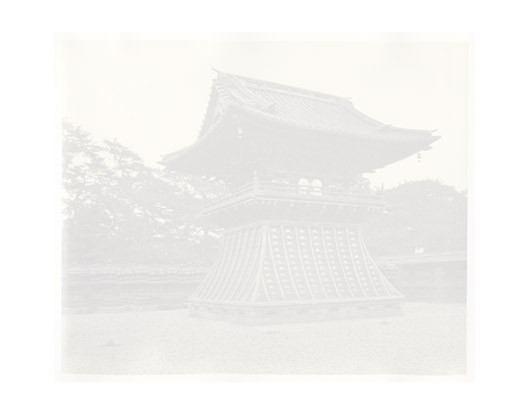
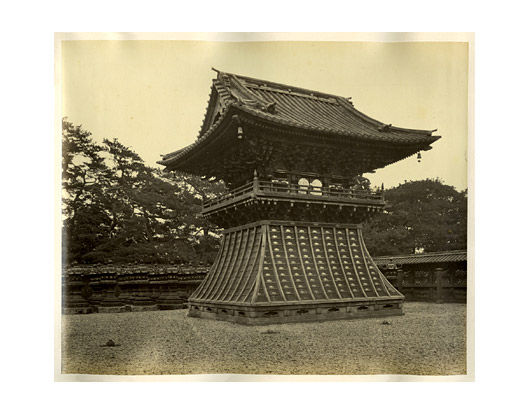
33
BURIAL GROUND OF THE TAIKUNS.
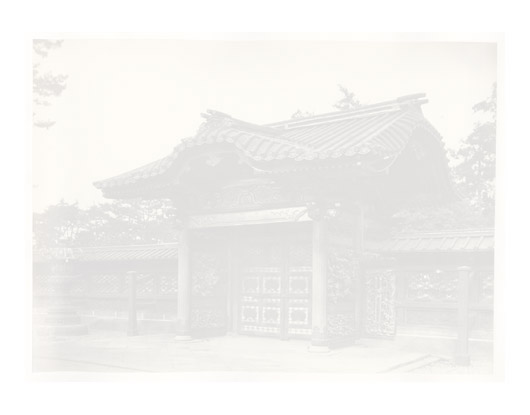
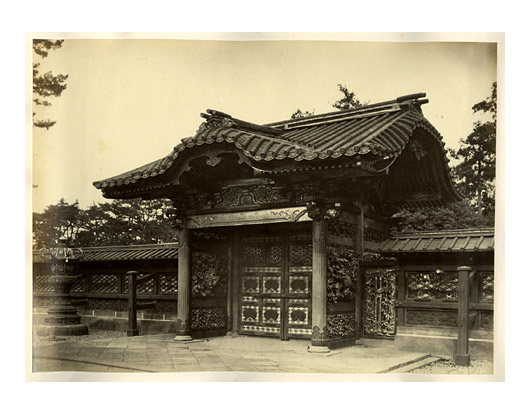
34
BURIAL GROUND OF THE TAIKUNS.
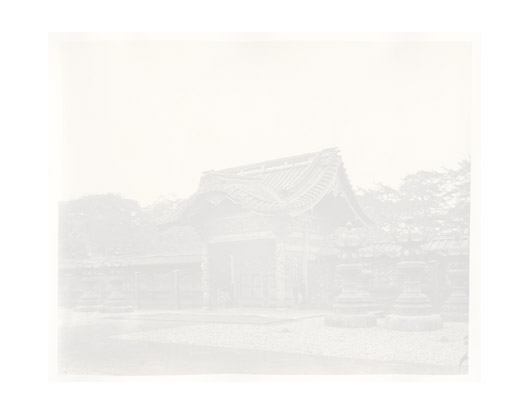
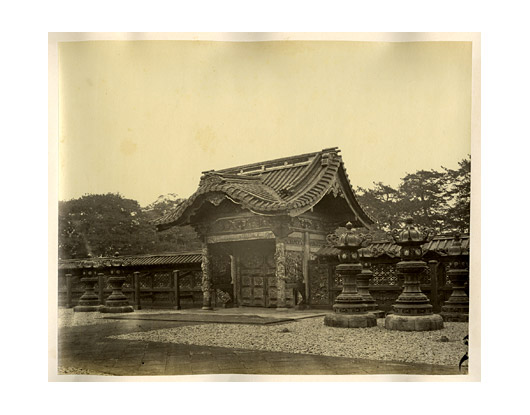
35
GATEWAY OF THE TYCOON’S PALACE YEDO.
A CAUSEWAY leads to the enclosure bounding the Tycoon’s palace grounds, and there is an imposing gateway, flanked on either side by buildings which form a courtyard; over the gates, in copper enamel, is the crest of the owner—an orange on a branch with three leaves.
It was near this spot that the Gotairo, or Regent of the Empire, was set upon and assassinated by a band of ruffians, in broad daylight, on the 24th March 1860; and although surrounded by his own retainers, and in his own norimon, Iko-mono-no-kami (the Gotairo) was not only killed but his head was carried off by an assailant before he could be arrested.
A CAUSEWAY leads to the enclosure bounding the Tycoon’s palace grounds, and there is an imposing gateway, flanked on either side by buildings which form a courtyard; over the gates, in copper enamel, is the crest of the owner—an orange on a branch with three leaves.
It was near this spot that the Gotairo, or Regent of the Empire, was set upon and assassinated by a band of ruffians, in broad daylight, on the 24th March 1860; and although surrounded by his own retainers, and in his own norimon, Iko-mono-no-kami (the Gotairo) was not only killed but his head was carried off by an assailant before he could be arrested.
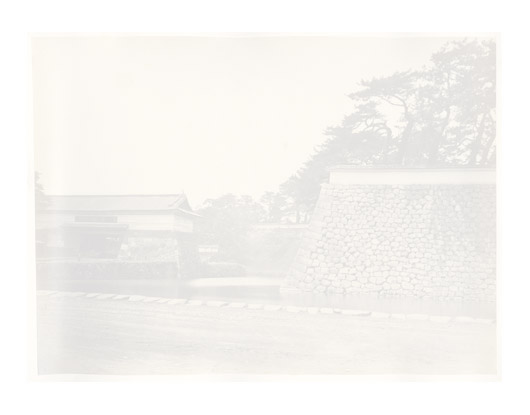
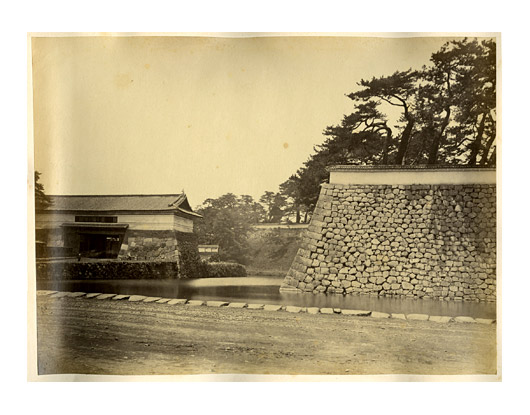
36
CASTLE OF YEDO,—INNER MOAT.
THE Castle of Yedo, for Two Hundred and Sixty years the residence of the Taikuns, and now (1869,) that of the Mikado of Japan, was built in the beginning of the seventeenth century, by Iyeyasu, the great founder of the last dynasty of Taikuns, or Shioguns. An older Castle had, however, previously existed on the spot where now stands the Nishi-no-Maru, or Western Palace. It was built, according to one account at least, by Ota-do-kan, a noted retainer of a former dynasty. The Hon-Maru, or principal palace, with the moats as they now exist, are the work of Iyeyasu. The Nishi-no-Maru is seen in the view at the farther end of the bridge, while the Hon-maru occupies the space behind the spot where the spectator is supposed to be standing.
THE Castle of Yedo, for Two Hundred and Sixty years the residence of the Taikuns, and now (1869,) that of the Mikado of Japan, was built in the beginning of the seventeenth century, by Iyeyasu, the great founder of the last dynasty of Taikuns, or Shioguns. An older Castle had, however, previously existed on the spot where now stands the Nishi-no-Maru, or Western Palace. It was built, according to one account at least, by Ota-do-kan, a noted retainer of a former dynasty. The Hon-Maru, or principal palace, with the moats as they now exist, are the work of Iyeyasu. The Nishi-no-Maru is seen in the view at the farther end of the bridge, while the Hon-maru occupies the space behind the spot where the spectator is supposed to be standing.
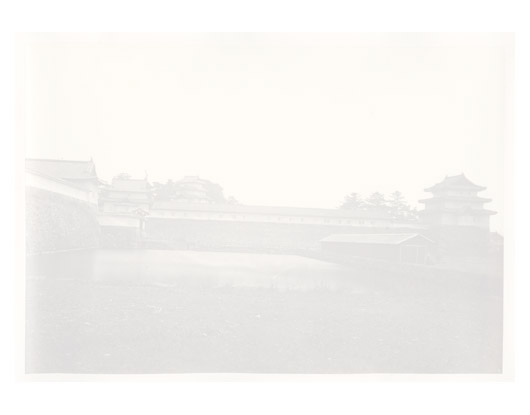
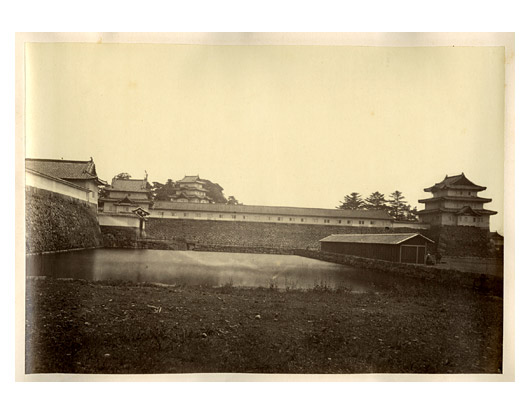
37
MOATS ROUND THE TYCOON’S PALACE—YEDO.
THESE moats have been often described, but they cover such a large space of ground, that it is difficult to give an idea of their extent without a plan of the central portion of the city of Yedo. Fortune, in speaking of them says, “I may compare the moat to a rope loosely coiled; the end of the outer coil dipping as it were into the river (Todogawa) and supplying the whole with water. It is not correct to say, as is sometimes said, that there are three concentric circles, each surrounded by a moat. The Tycoon’s palace and the offices of his ministers are situated in the centre of the coil, while the outer and wider portion encircles the mansions of the feudal princes.” Numerous substantial bridges cross the moat or moats; the streets in this part of Yedo are wider and more regular than elsewhere—and from the number of Daimio’s palaces, the buildings are both substantial and imposing. The inner town of the coil, which as it were, specially encircles the Tycoon’s grounds, is in parts faced with high steep banks, ornamented with fine groups of stately junipers, pines, and other trees, and green with luxuriant turf…
THESE moats have been often described, but they cover such a large space of ground, that it is difficult to give an idea of their extent without a plan of the central portion of the city of Yedo. Fortune, in speaking of them says, “I may compare the moat to a rope loosely coiled; the end of the outer coil dipping as it were into the river (Todogawa) and supplying the whole with water. It is not correct to say, as is sometimes said, that there are three concentric circles, each surrounded by a moat. The Tycoon’s palace and the offices of his ministers are situated in the centre of the coil, while the outer and wider portion encircles the mansions of the feudal princes.” Numerous substantial bridges cross the moat or moats; the streets in this part of Yedo are wider and more regular than elsewhere—and from the number of Daimio’s palaces, the buildings are both substantial and imposing. The inner town of the coil, which as it were, specially encircles the Tycoon’s grounds, is in parts faced with high steep banks, ornamented with fine groups of stately junipers, pines, and other trees, and green with luxuriant turf…
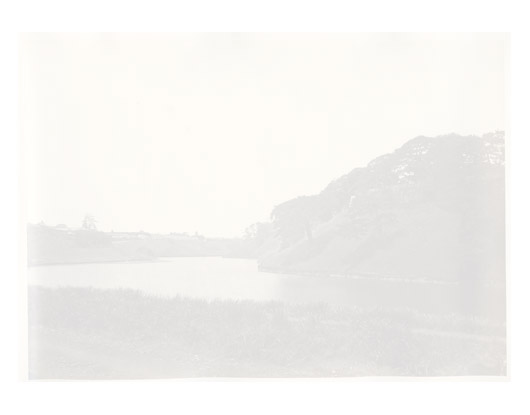
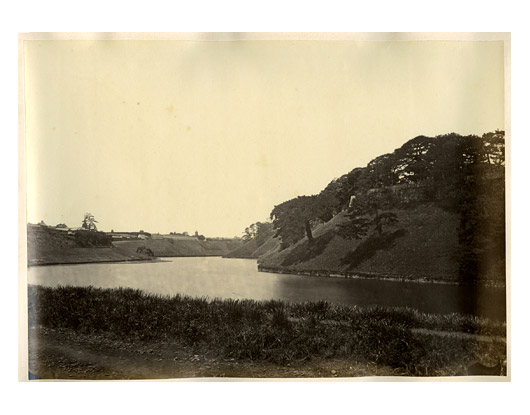
38
CASCADE AT JIU-NI-SO.
ALTHOUGH the picturesque beauty of this delightful spot doubtless alone attracts numerous visitors in summer, there is a large proportion of its frequenters at that season who are induced to make a pilgrimage to this place from a superstitious belief in the extraordinary virtue of its waters. Not only is it generally supposed that a plunge in any of the pools at the foot of the cascade has the effect of inducing and materially developing the inspiration of juvenile poets, but there are many who are brought from great distances by their friends, with the firm belief that diseases of the brain, such as idiotcy—and even confirmed insanity—may be cured by placing the patients under the waterfall. Numbers of shivering creatures may often be seen, who are undergoing this supposed cold-water cure; but by all accounts, few benefit by the exposure to its limpid stream. …
ALTHOUGH the picturesque beauty of this delightful spot doubtless alone attracts numerous visitors in summer, there is a large proportion of its frequenters at that season who are induced to make a pilgrimage to this place from a superstitious belief in the extraordinary virtue of its waters. Not only is it generally supposed that a plunge in any of the pools at the foot of the cascade has the effect of inducing and materially developing the inspiration of juvenile poets, but there are many who are brought from great distances by their friends, with the firm belief that diseases of the brain, such as idiotcy—and even confirmed insanity—may be cured by placing the patients under the waterfall. Numbers of shivering creatures may often be seen, who are undergoing this supposed cold-water cure; but by all accounts, few benefit by the exposure to its limpid stream. …
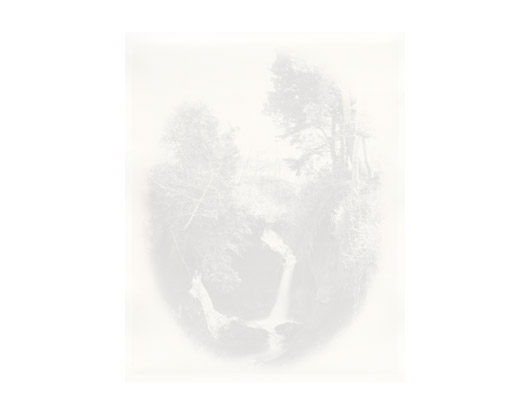
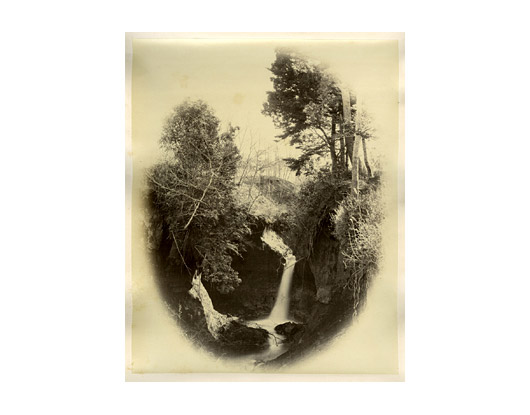
39
CEMETERY OF THE TEMPLE OF SHUN-TO-KOJI, OR “SPRING VIRTUE” TEMPLE, NAGASAKI.
THIS is looked upon as the aristocratic burying ground of Nagasaki, and the enclosing walls shown bound small spaces in which the dead of one family repose. The tombstones are of various forms, sometimes rough, but more frequently hewn into oblong blocks which are placed on end. Those with caps or capitols are for wealthy men; others may use this form if they prefer it although it is not customary to do so. In front of these tombstones are placed vessels made of the single joint of a large bamboo, containing water, in which branches of flowers are stuck.
The Japanese have two ways of disposing of their dead—interment and burning—and persons about to die generally state which method they prefer; the body is placed in a sitting posture in a tub shaped coffin which again is enclosed in a square box, or bier, with a roof-shaped top, which is always white, that being the mourning colour in Japan. …
THIS is looked upon as the aristocratic burying ground of Nagasaki, and the enclosing walls shown bound small spaces in which the dead of one family repose. The tombstones are of various forms, sometimes rough, but more frequently hewn into oblong blocks which are placed on end. Those with caps or capitols are for wealthy men; others may use this form if they prefer it although it is not customary to do so. In front of these tombstones are placed vessels made of the single joint of a large bamboo, containing water, in which branches of flowers are stuck.
The Japanese have two ways of disposing of their dead—interment and burning—and persons about to die generally state which method they prefer; the body is placed in a sitting posture in a tub shaped coffin which again is enclosed in a square box, or bier, with a roof-shaped top, which is always white, that being the mourning colour in Japan. …
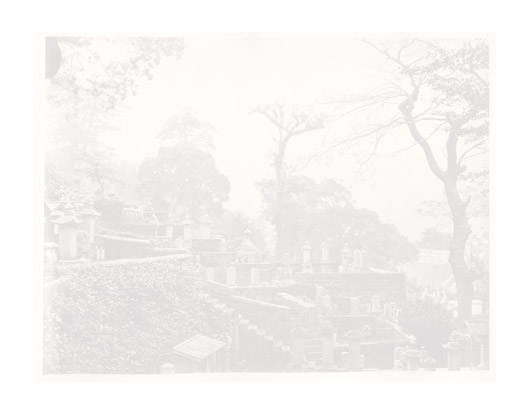
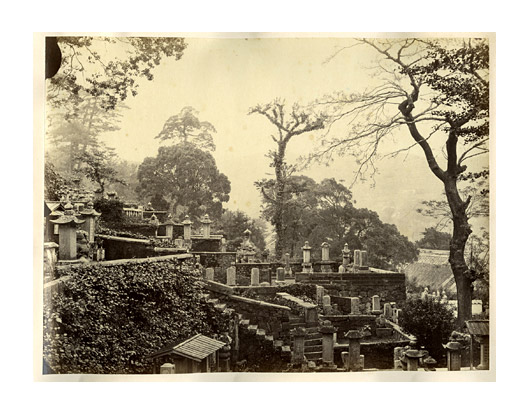
40
TEMPLE OF ASAXA, YEDO.
This temple, one of the largest and wealthiest in Japan, is sacred not only to devotion and worship, but serves also for recreation and diversion. It is adorned with pleasant gardens and elegant walks; and inside the paved street or pathway approaching it, are stalls filled with attractive wares, which give the place always a holiday appearance as if an endless fair were being held. Among other attractions to devotees in this celebrated Temple, is one special golden image, which is never allowed to be seen more than once in about thirteen years. This image, said to be still covered with evidences of long submersion, is believed to have been fished up from the sea centuries ago, when Yedo was first founded; and from that time to the present day, has been an object of worship. In the district of Asaxa, where this temple is situated, resides the "King of the Beggars”—who form a distinct class in Japan, governed by special laws applying to themselves alone; and who in the event of war are bound to follow the army and bury all who are killed in action or die during the campaign; on them also devolves the duty of burying all who are executed for offences against the law, or who may be found dead. …
This temple, one of the largest and wealthiest in Japan, is sacred not only to devotion and worship, but serves also for recreation and diversion. It is adorned with pleasant gardens and elegant walks; and inside the paved street or pathway approaching it, are stalls filled with attractive wares, which give the place always a holiday appearance as if an endless fair were being held. Among other attractions to devotees in this celebrated Temple, is one special golden image, which is never allowed to be seen more than once in about thirteen years. This image, said to be still covered with evidences of long submersion, is believed to have been fished up from the sea centuries ago, when Yedo was first founded; and from that time to the present day, has been an object of worship. In the district of Asaxa, where this temple is situated, resides the "King of the Beggars”—who form a distinct class in Japan, governed by special laws applying to themselves alone; and who in the event of war are bound to follow the army and bury all who are killed in action or die during the campaign; on them also devolves the duty of burying all who are executed for offences against the law, or who may be found dead. …
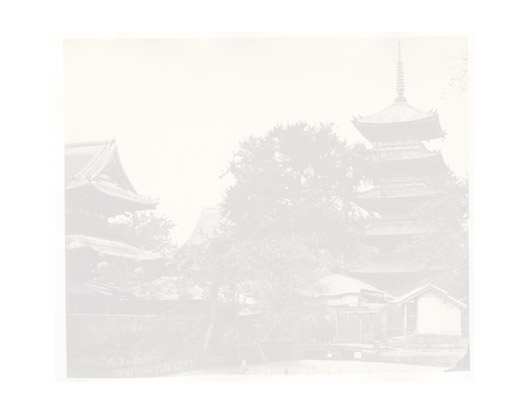
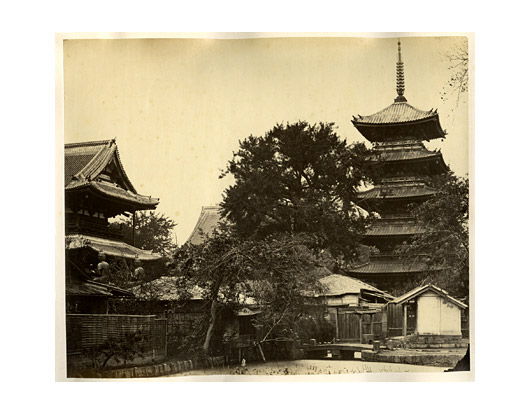
41
THE TYCOON’S SUMMER GARDENS AT YEDO.
MR. LEIGHTON remarks with reference to the Japanese—“They seem fond of sensations, the sweet, the soft, and pretty is heightened by the grotesque, yet all in harmony.” In all their gardens and grounds there is a great similarity of ornament; miniature lakes of more or less capacity, will trimmed lawns of smooth green turf—varieties of quaintly trimmed shrubs, and trees tortured into queer shapes, imitating junks under full sail, candelabra, tortoises, cranes and other objects, abound. The graceful bamboo, the more stately forest trees, shrubs with variegated leaves, alternate with clusters of azaleas, and bright flowers in profusion. Pretty little tea-houses—bridges spanning artificial ponds where gold-fish are kept—platforms also projecting into these little lakes, where anglers may amuse themselves; and trellis-work arbours with vines and creepers trained over them, are not wanting in this quiet retreat of the Tycoon. There is one part of these gardens set aside for hawking—a sport which is reserved for the higher and privileged classes in most parts of Japan, and is limited to the Tycoon alone within his domain—so much so that no private individual may even keep a falcon.
MR. LEIGHTON remarks with reference to the Japanese—“They seem fond of sensations, the sweet, the soft, and pretty is heightened by the grotesque, yet all in harmony.” In all their gardens and grounds there is a great similarity of ornament; miniature lakes of more or less capacity, will trimmed lawns of smooth green turf—varieties of quaintly trimmed shrubs, and trees tortured into queer shapes, imitating junks under full sail, candelabra, tortoises, cranes and other objects, abound. The graceful bamboo, the more stately forest trees, shrubs with variegated leaves, alternate with clusters of azaleas, and bright flowers in profusion. Pretty little tea-houses—bridges spanning artificial ponds where gold-fish are kept—platforms also projecting into these little lakes, where anglers may amuse themselves; and trellis-work arbours with vines and creepers trained over them, are not wanting in this quiet retreat of the Tycoon. There is one part of these gardens set aside for hawking—a sport which is reserved for the higher and privileged classes in most parts of Japan, and is limited to the Tycoon alone within his domain—so much so that no private individual may even keep a falcon.
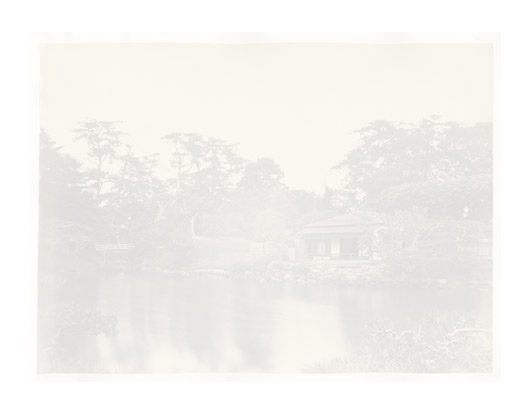
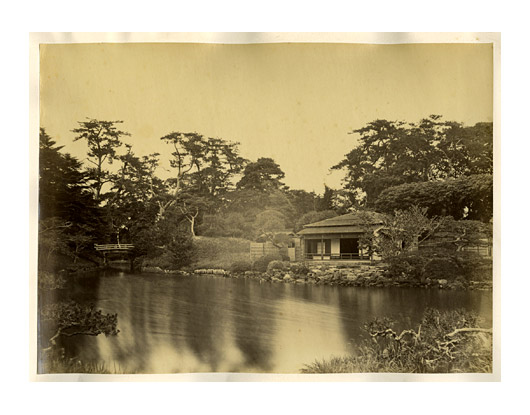
42
YOKOHAMA.
IN THE beginning of 1859, Yokohama was an insignificant fishing village, in the midst of a marsh on the opposite side of the bay to Kanagawa, which town was originally the one named by Treaty to be opened to Foreign trade on the 1st July, 1859. Whether the Japanese conceived that by placing Foreigners in a comparatively isolated position, they could exercise a greater restriction on intercourse, or whether they saw that the position of Yokohama was better adapted for landing and shipping purposes, is now of little consequence; but they voluntarily went to great expense in constructing a causeway connecting Yokohama with the Tokaido, and in building piers and landing places; they moved as if by magic, a considerable number of people and houses, and erected sundry small godowns, &c., in anticipation of the arrival of foreign merchants; and although the foreign Consuls were at first domiciled at Kanagawa, and Ministers demurred at what seemed to be an evasion of the letter of the Treaty, still Yokohama, from the fact of its greater convenience as a shipping place, grew and increased daily. …
IN THE beginning of 1859, Yokohama was an insignificant fishing village, in the midst of a marsh on the opposite side of the bay to Kanagawa, which town was originally the one named by Treaty to be opened to Foreign trade on the 1st July, 1859. Whether the Japanese conceived that by placing Foreigners in a comparatively isolated position, they could exercise a greater restriction on intercourse, or whether they saw that the position of Yokohama was better adapted for landing and shipping purposes, is now of little consequence; but they voluntarily went to great expense in constructing a causeway connecting Yokohama with the Tokaido, and in building piers and landing places; they moved as if by magic, a considerable number of people and houses, and erected sundry small godowns, &c., in anticipation of the arrival of foreign merchants; and although the foreign Consuls were at first domiciled at Kanagawa, and Ministers demurred at what seemed to be an evasion of the letter of the Treaty, still Yokohama, from the fact of its greater convenience as a shipping place, grew and increased daily. …
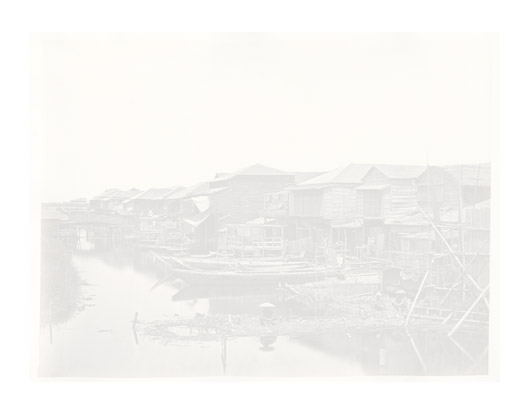
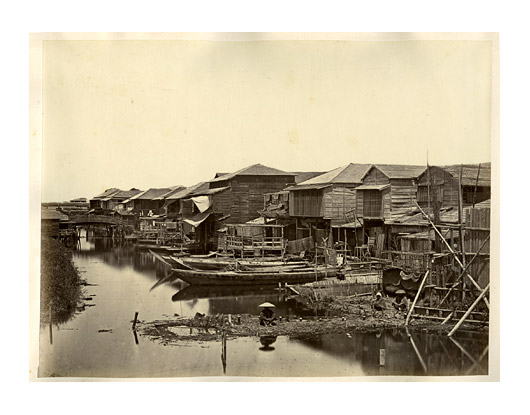
43
VIEW FROM THE FRENCH BLUFF.
IN the early days of the occupation of Yokohama, the existence of such restraints as a broad Creek, the bridges of which were jealously watched—guard-houses on every commanding height, and the presence of strong bodies of troops, shewed a decided inclination on the part of the Japanese to renew the same exclusive policy and the same offensive espionage in the case of foreigners of other nationalities, notwithstanding the exchange of more liberal treaties, as had for so many years been pursued towards the Dutch at Decima, in the harbour of Nagasaki.
To the French is the credit due of having in 1863 first advanced across the canal and of having established themselves on the height overlooking the town and bay of Yokohama. Since then the hill has been neatly laid out with graveled walks and ornamental beds of flowers, and extensive Barracks and Coal Sheds have been erected at its base. …
IN the early days of the occupation of Yokohama, the existence of such restraints as a broad Creek, the bridges of which were jealously watched—guard-houses on every commanding height, and the presence of strong bodies of troops, shewed a decided inclination on the part of the Japanese to renew the same exclusive policy and the same offensive espionage in the case of foreigners of other nationalities, notwithstanding the exchange of more liberal treaties, as had for so many years been pursued towards the Dutch at Decima, in the harbour of Nagasaki.
To the French is the credit due of having in 1863 first advanced across the canal and of having established themselves on the height overlooking the town and bay of Yokohama. Since then the hill has been neatly laid out with graveled walks and ornamental beds of flowers, and extensive Barracks and Coal Sheds have been erected at its base. …
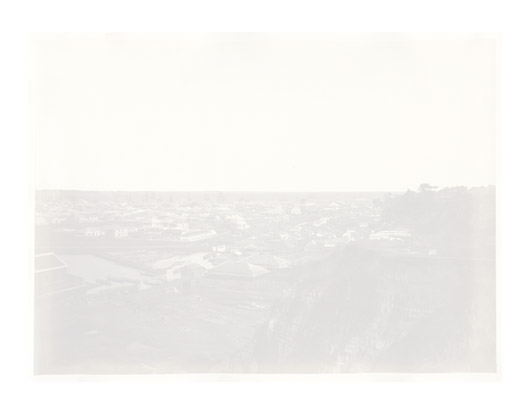
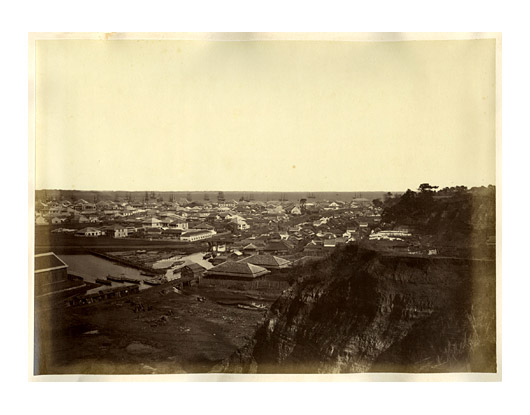
44
YOKOHAMA.
… At the end of the third year from the opening of the Port the foreign community numbered 126; from that time, however, it has multiplied considerably.
On the 26th November 1866, Yokohama, which had progressed since its establishment in 1859 with a healthfulness and rapidity its most sanguine well-wishers could hardly have foreseen, was visited by a calamitous fire, which swept away a large portion of the Native town and about one-third of the Foreign settlement, destroying insured property to the amount of two million and-a-half of dollars, besides a great deal that was uninsured; and, for a short time staggered its energies. Within one year however it has, notwithstanding a time of unprecedented commercial depression, gradually recovered; and may now be said to promise a steadiness of advance, which will, in all probability lead to its eventually being the most substantial sea-port town in the Japanese empire. …
… At the end of the third year from the opening of the Port the foreign community numbered 126; from that time, however, it has multiplied considerably.
On the 26th November 1866, Yokohama, which had progressed since its establishment in 1859 with a healthfulness and rapidity its most sanguine well-wishers could hardly have foreseen, was visited by a calamitous fire, which swept away a large portion of the Native town and about one-third of the Foreign settlement, destroying insured property to the amount of two million and-a-half of dollars, besides a great deal that was uninsured; and, for a short time staggered its energies. Within one year however it has, notwithstanding a time of unprecedented commercial depression, gradually recovered; and may now be said to promise a steadiness of advance, which will, in all probability lead to its eventually being the most substantial sea-port town in the Japanese empire. …
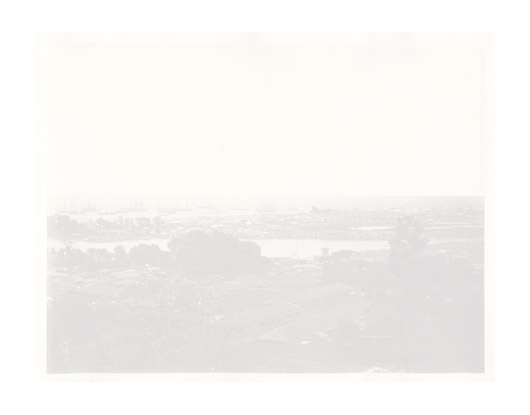
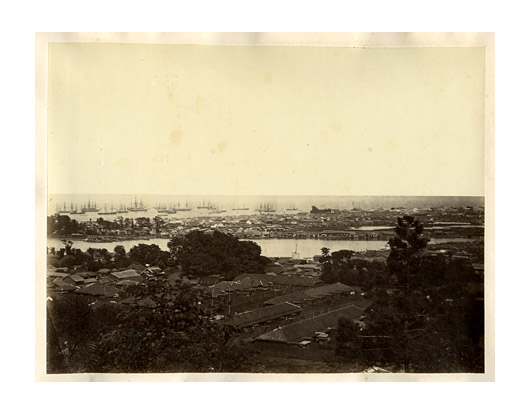
45
VILLAGE OF DIABOUTS.
A prominent object at the end of the street, the houses on either side of which form the village of Diabouts, is a temple dedicated to Dri-annnon-Sama, who appears to be the god corresponding to Bacchus in ancient Mythology. The idol is a colossal wooden one, which may be roughly estimated to be about 60 feet in height, and entirely gilt. The expression of the face is happy, and “jolly” wreaths and clusters of grape leaves and fruit surround the head. The statue reaches to the apex of the roof, is kept in darkness, and can only be seen, by the visitor, with the aid of small lamps which, for a consideration, are hoisted up by pulleys arranged for the purpose. The terrace in front of the temple commands an extensive view of the bay below and the distant promontory of Sagami. On the right as we ascend there is a statue of Daibouts, with the head surrounded by a halo of Lotus, in gum, edged with gold. In the court yard below are stuck up the names of numerous subscribers for the restoration and repair of the temple and statue who thus publish to the world their charity or devotedness.
A prominent object at the end of the street, the houses on either side of which form the village of Diabouts, is a temple dedicated to Dri-annnon-Sama, who appears to be the god corresponding to Bacchus in ancient Mythology. The idol is a colossal wooden one, which may be roughly estimated to be about 60 feet in height, and entirely gilt. The expression of the face is happy, and “jolly” wreaths and clusters of grape leaves and fruit surround the head. The statue reaches to the apex of the roof, is kept in darkness, and can only be seen, by the visitor, with the aid of small lamps which, for a consideration, are hoisted up by pulleys arranged for the purpose. The terrace in front of the temple commands an extensive view of the bay below and the distant promontory of Sagami. On the right as we ascend there is a statue of Daibouts, with the head surrounded by a halo of Lotus, in gum, edged with gold. In the court yard below are stuck up the names of numerous subscribers for the restoration and repair of the temple and statue who thus publish to the world their charity or devotedness.
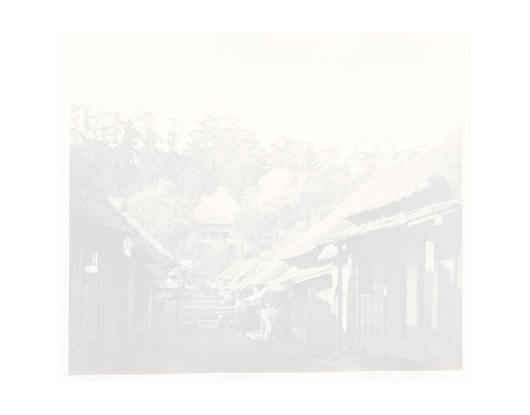
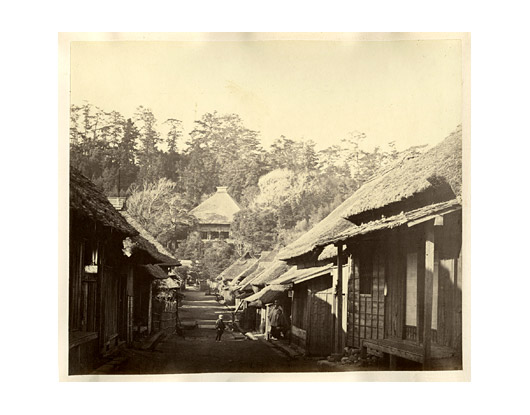
46
VIEW OF THE HARBOUR, NAGASAKI.
THE harbour of Nagasaki is perhaps one of the most beautiful in the world,—it is from three to four miles in length, and a mile in width—sheltered by high hills on either side, wooded or under cultivation to their summits. The native town is well laid out, and said to contain some 70,000 inhabitants. The foreign settlement has steadily advanced in size and importance since 1859—and with its well lighted Bund, clean streets and increasing trade, bids fair to rival its larger sister, Yokohama. … On the opposite side of the Bay there is an old established factory, where Japanese artisans worked under the supervision of Dutch instructors; but even in this, although the Japanese made use of the services of men obtained by Dutch intervention, their exclusive policy was so far continued, as to prohibit any attempt to acquire the Japanese language—and compelled the use of an interpreter in all intercourse between workman and teacher. Since 1850, however, they have removed these restrictions, and have now a large foundry and machine shop under European direction.
THE harbour of Nagasaki is perhaps one of the most beautiful in the world,—it is from three to four miles in length, and a mile in width—sheltered by high hills on either side, wooded or under cultivation to their summits. The native town is well laid out, and said to contain some 70,000 inhabitants. The foreign settlement has steadily advanced in size and importance since 1859—and with its well lighted Bund, clean streets and increasing trade, bids fair to rival its larger sister, Yokohama. … On the opposite side of the Bay there is an old established factory, where Japanese artisans worked under the supervision of Dutch instructors; but even in this, although the Japanese made use of the services of men obtained by Dutch intervention, their exclusive policy was so far continued, as to prohibit any attempt to acquire the Japanese language—and compelled the use of an interpreter in all intercourse between workman and teacher. Since 1850, however, they have removed these restrictions, and have now a large foundry and machine shop under European direction.
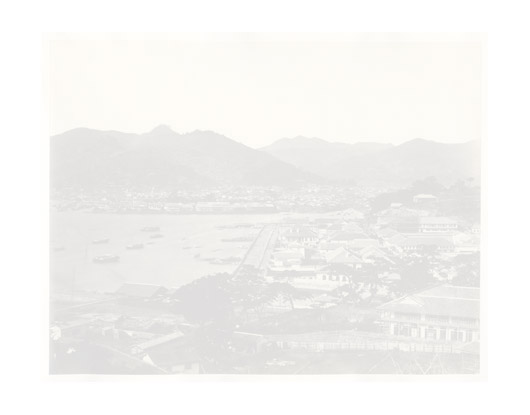
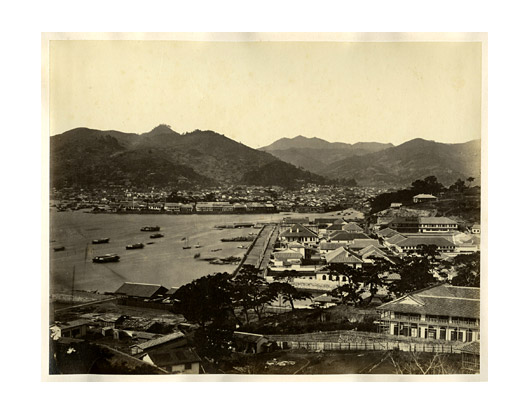
47
VIEW IN THE NATIVE TOWN—NAGASKI.
THIS town was originally the nursery of Christianity in Japan, and owes its rise to the impetuous zeal of a baptized Prince of Omura, who A. D. 1568 invited the Portuguese Catholic Missionaries to make it their head quarters and built a church there—and with the hot headed intolerance of a new convert was not satisfied with destroying the idols which himself and his forefathers had worshipped, but tried to prohibit old ceremonies and to compel his subjects to adopt the tenets of, to them, a new religion. The fate of thousands of martyrs at Ximabara in 1637, when, in fact, Christianity was virtually exterminated in Japan, was indirectly the consequence of ill judged attempts like this, to force by human means alone, the charitable principles of Christianity on unwilling minds; another undoubted proof, added to the many in our own history, that the sword wins not converts, and that conviction leads men, and thinking men only, to worship the only true God; and that the humble belief in the admirable beauties of Holy writ is more powerful than all the gilded pageantry of royal crusades, or the wordly weight of princely proselytism unassisted by the blessing of Him who rules by love. …
THIS town was originally the nursery of Christianity in Japan, and owes its rise to the impetuous zeal of a baptized Prince of Omura, who A. D. 1568 invited the Portuguese Catholic Missionaries to make it their head quarters and built a church there—and with the hot headed intolerance of a new convert was not satisfied with destroying the idols which himself and his forefathers had worshipped, but tried to prohibit old ceremonies and to compel his subjects to adopt the tenets of, to them, a new religion. The fate of thousands of martyrs at Ximabara in 1637, when, in fact, Christianity was virtually exterminated in Japan, was indirectly the consequence of ill judged attempts like this, to force by human means alone, the charitable principles of Christianity on unwilling minds; another undoubted proof, added to the many in our own history, that the sword wins not converts, and that conviction leads men, and thinking men only, to worship the only true God; and that the humble belief in the admirable beauties of Holy writ is more powerful than all the gilded pageantry of royal crusades, or the wordly weight of princely proselytism unassisted by the blessing of Him who rules by love. …
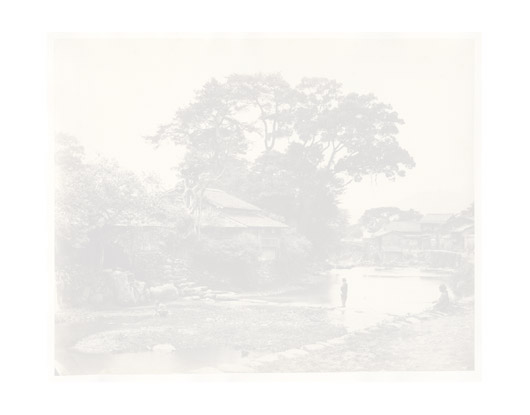
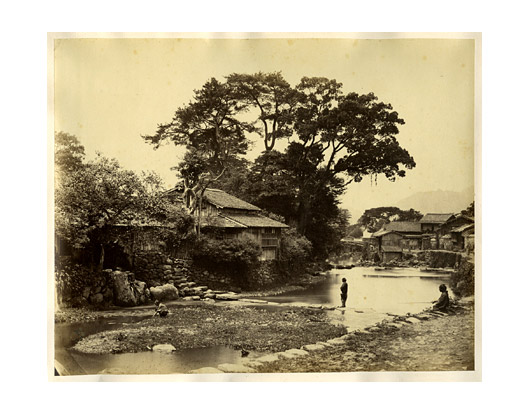
48
TEMPLE OF DAI-OON-JI—NAGASAKI.
THIS Temple of Dai-oon-ji, or “loud Noise,” is a Buddhist temple, and one of those which are supported by the Government.
These Temples furnish the only specimens of what may be looked upon as the Japanese style of Architecture in this land of frequently recurring earthquakes. To the casual observer there is a wonderful sameness in all buildings of this sort, and it is only the familiarity with details, and minutiae of ornaments, &c., that enables one to distinguish any difference between one temple and another. The general outline—the mode of construction and the material, which is invariably wood, are the same in most instances. Some temples are roofed with tiles, while many others are thatched; the latter, perhaps, are the most curious, the enormous thickness of the thatch, often as much as three to four feet, the compact, neat, and even ornamental way in which it is cut and trimmed, strike one as being peculiar, but beyond this difference there is little to vary the sameness of all temples. …
THIS Temple of Dai-oon-ji, or “loud Noise,” is a Buddhist temple, and one of those which are supported by the Government.
These Temples furnish the only specimens of what may be looked upon as the Japanese style of Architecture in this land of frequently recurring earthquakes. To the casual observer there is a wonderful sameness in all buildings of this sort, and it is only the familiarity with details, and minutiae of ornaments, &c., that enables one to distinguish any difference between one temple and another. The general outline—the mode of construction and the material, which is invariably wood, are the same in most instances. Some temples are roofed with tiles, while many others are thatched; the latter, perhaps, are the most curious, the enormous thickness of the thatch, often as much as three to four feet, the compact, neat, and even ornamental way in which it is cut and trimmed, strike one as being peculiar, but beyond this difference there is little to vary the sameness of all temples. …
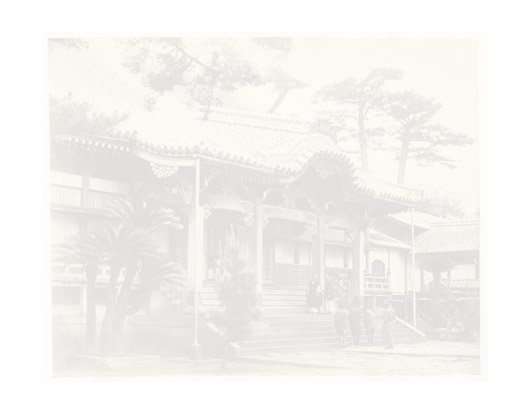
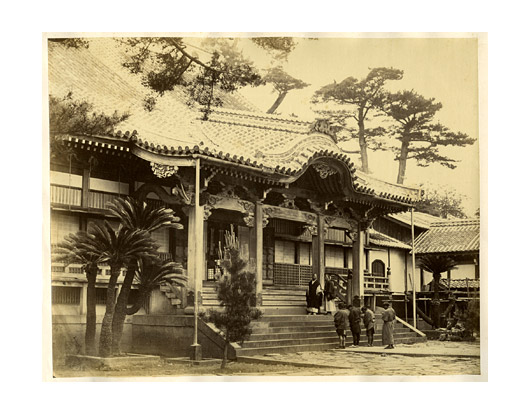
49
JUNKS, OR COASTING VESSELS.
These vessels are of peculiar construction, they have open sterns with a strong bulkhead aft to keep the water from flowing into the hole. The rudder is large and unwieldy and is hoisted up or lowered by means of runners worked by a windlass fitted in the cabin, which latter is also used in connection with one of the forecastle for hoisting and lowering the mast and sail. The cause assigned for requiring the sterns of all vessels to be constructed in this way is to render more convenient the management of the rudder, Kempfer and other writers ascribe it to the suspicious policy of the government, which forbids any of its vessels to visit foreign countries. They have but one mast, placed about one third from the stern post, and but one sail, a lug with a square yard, which is worked with braces, with numerous tacks and bowlines, which are useful when on a wind. Ship builders are not permitted to deviate from a uniform rule, in model, size or rig, as well as interior arrangement. These junks are about one hundred tons burthen, and in traveling from port to port they keep close in shore, and anchor in some convenient harbour whenever the weather is boisterous. …
These vessels are of peculiar construction, they have open sterns with a strong bulkhead aft to keep the water from flowing into the hole. The rudder is large and unwieldy and is hoisted up or lowered by means of runners worked by a windlass fitted in the cabin, which latter is also used in connection with one of the forecastle for hoisting and lowering the mast and sail. The cause assigned for requiring the sterns of all vessels to be constructed in this way is to render more convenient the management of the rudder, Kempfer and other writers ascribe it to the suspicious policy of the government, which forbids any of its vessels to visit foreign countries. They have but one mast, placed about one third from the stern post, and but one sail, a lug with a square yard, which is worked with braces, with numerous tacks and bowlines, which are useful when on a wind. Ship builders are not permitted to deviate from a uniform rule, in model, size or rig, as well as interior arrangement. These junks are about one hundred tons burthen, and in traveling from port to port they keep close in shore, and anchor in some convenient harbour whenever the weather is boisterous. …
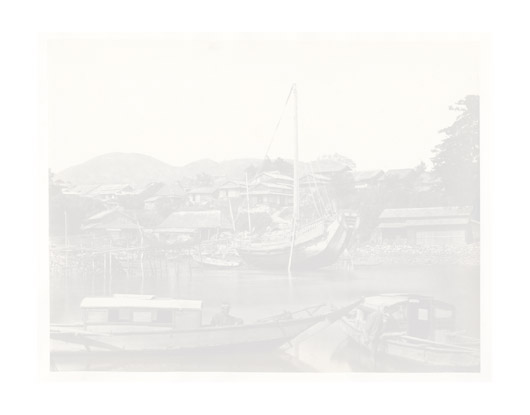
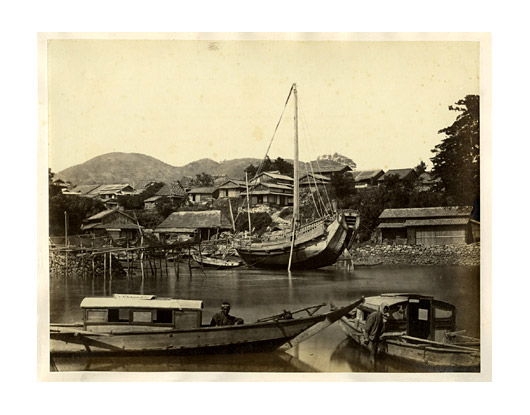
50


